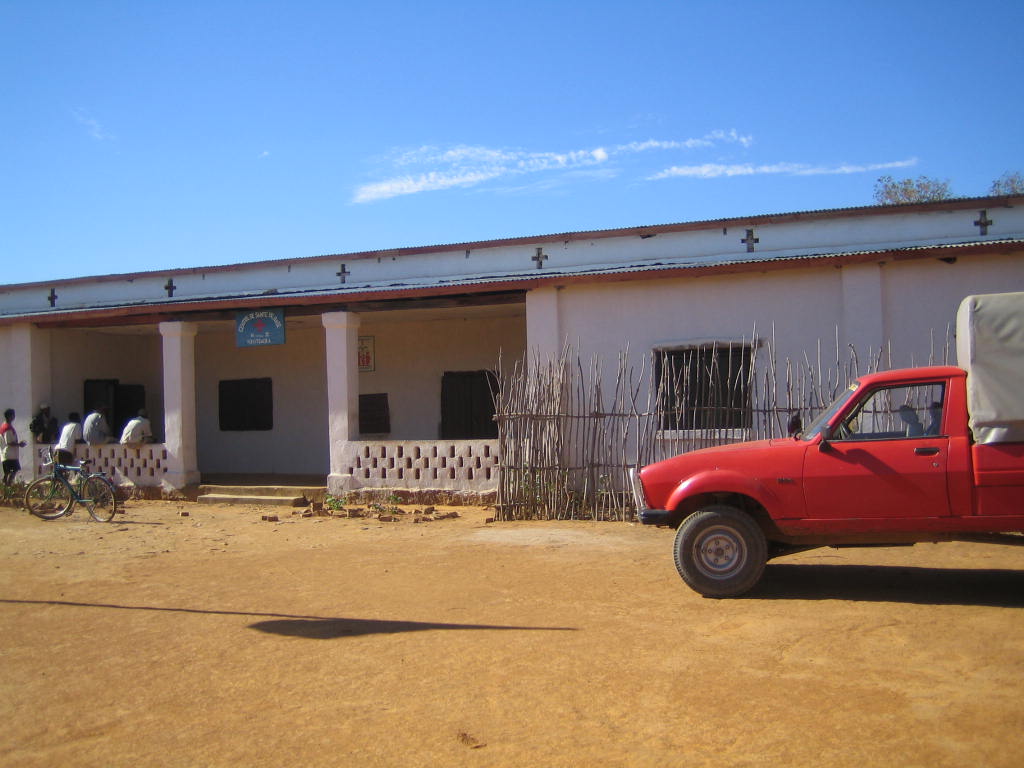Madagascar September 26 to November 2, 2006

Antananarivo (Tana), Tuesday morning, September 26, 2006
“Passenger Dorothee Fleck, please come to counter 21!” That’s how it all started after Regine and Andreas had safely taken me to the airport. I quickly said goodbye and reported obediently. For the first time on all my tours, they discovered my gas cartridges, which I had stowed safely in my panniers. Now, of course, I had to leave them there. It’ll be fun trying to find them again in Madagascar. Checking in the bike was no problem, apart from the €80 fee.
Finally, I’m here, a 20 year old dream come true. Well, actually, the story behind it goes back a little further, but at the young and inexperienced age of about 24, I decided that I would only marry a man who was willing to spend our honeymoon cycling with me in Madagascar. Since I never found the man of my dreams, I now have the pleasure of going on my dream trip alone.
After all the quarrels at work, it’s now an incredibly feeling to finally be sitting in the Hotel Sakamanga, with the sun shining outside and six weeks of freedom and adventure ahead of me – on my bike, of course.
The flight was long, more than ten hours from Paris, but otherwise quite pleasant. What was unpleasant at the end was the long wait at immigration and then at the bank to exchange money. Since I am now at an age where I allow myself a little luxury from time to time, I booked an airport transfer to the hotel for the first time. To my excuse, I should add that my arrival time was shortly before 10 p.m., which meant it was almost midnight when I left the airport. Many Madagascan helpers were on hand to take my luggage, including my bike, and load it into the taxi. For a tip, of course. Since my visit to the bank, I had a plastic bag full of money. That amount doesn’t fit in a wallet. 1 euro is 2500 ariary.
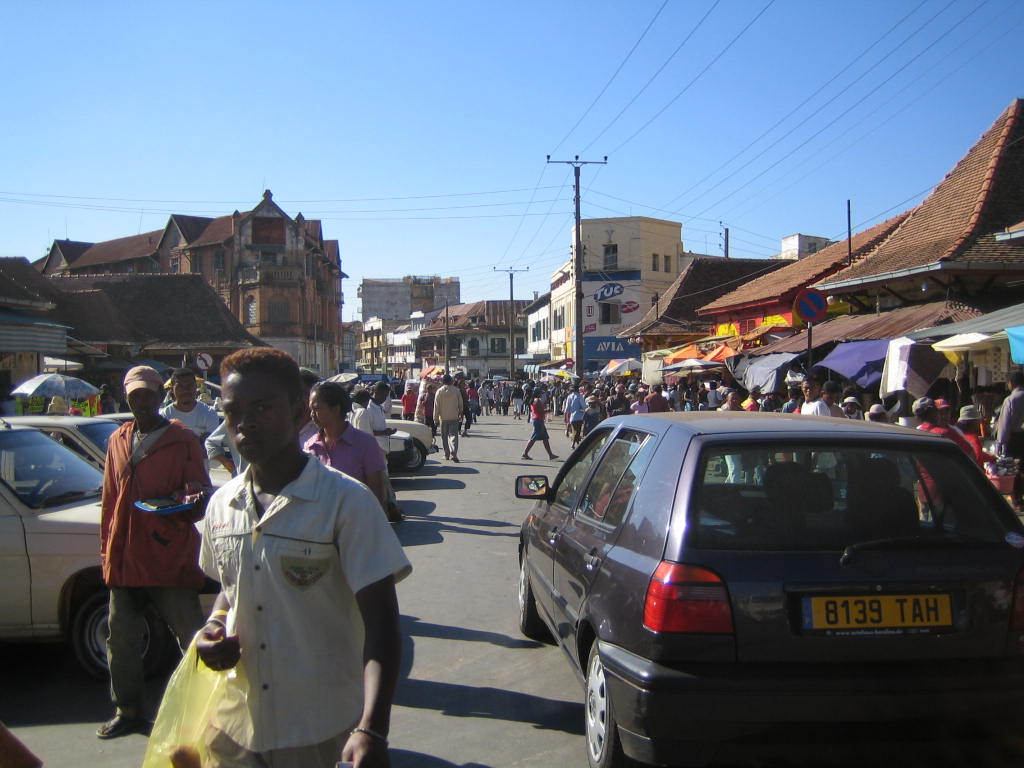
Tana 20 km Tuesday evening
Well, one thing is certain: this is going to be a wonderful adventure! Actually, it has already begun, and I am really excited. My bike is ready to go.
Today after breakfast, I set off on foot. It was quite early, but I was already confronted with all the misery of the city. The guy who picked me up from the airport yesterday said that the city now has 3.2 million inhabitants. Now I believe him. The tens of thousands of homeless children I’ve read about are also undeniable. It’s really frightening, and everywhere stinks of urine. Children are always scurrying between your legs. Most of the time, like the mothers with their children on their backs, they want money. That doesn’t help them in the long run. I don’t want to buy vanilla, dictionaries, or embroidery, at least not yet. One of the most unpleasant things about it was that I didn’t know how to behave.
I had fewer problems with the hotel employee, whom I kept very busy. First, he helped me carry the bike box into the garage, where I was able to assemble it without any problems, naturally under the watchful gaze of curious observers. Then, without me even asking, he carried the bike box back to the storage room. One less problem for me, as I can also use the box for the return flight. Since I wanted to use my bike again and again, he was allowed to lock it up again and again. In short, he earned his tip fair and square.
I was also able to do all my shopping quite quickly: maps, gas cartridges, and the main component of my bike trip food: peanut butter with honey for breakfast and instant noodles in the evening.
Because of the camping gas, I cycled through the entire outskirts of Tana, which was very nice and gave me a beautiful view of the city.

But it wasn’t necessary to buy one, as I eventually found it in a supermarket on the outskirts of the city center. But this gave me an insight into what might await me in the coming weeks: streets lined with corrugated iron or wooden shacks. Tourists rarely stray into this area, and certainly not on bicycles. It’s worth mentioning that I always wore a helmet, which is unusual here, of course. But it made some people laugh, and I laughed along with them. I also noticed that there are lots of bike shops along the road.
At first, I didn’t want to go shopping by bike. When I wanted to test it after assembling it, the traffic on the cobblestone road was so heavy that I hardly dared to ride on the road. Tomorrow I definitely want to set off, and then with luggage – that won’t make it any easier. So I set off without luggage and it was really fun. Wow, I’m looking forward to tomorrow when I can really get going!
Ampefy 126 km Wednesday, September 27, 2006
What an excellent day. Here I am, sitting right next to the pigsty belonging to the kraal, who has kindly allowed me to camp on the meadow right by the lake. What a magnificent sunset!
First things first! Yes, I got up, quite early in fact. It’s already light here at 5 a.m. But of course, I can’t go without breakfast. First, I have to pack. Goodness, will I be able to fit everything in? In the end, I managed, but it was quite heavy. The first climb came right at the beginning. Freshly strengthened, it was no problem. Then it was 6 km through misery.

Hard to believe, but there really is a bike path, probably the only one in all of Madagascar. Only you couldn’t ride on it. You have to remember that most people walk. If they’re lucky, they only have to carry something on their heads, otherwise they pull or push carts, and of course they do that on the bike path. Once I got past that, I came to one village after another, with rice terraces, pineapple fields, and mango trees in between. The whole area was quite fertile and hilly. Only after about 40 km did things calm down and I realized I was riding through Africa: mud huts everywhere, countless black children, women carrying excessive loads on their heads, zebu carts instead of cars, and everything done by hand. At first, I was surprised that everything was so clean. But then I started to see garbage dumps here and there.
It seems as if they have just discovered brick burning for themselves. The roadside is lined with it, which is not exactly conducive to air pollution control. The women carry the bricks on their heads, sometimes for quite long distances, where they are then stacked on top of each other to form two-story houses. Apparently, only the rich can afford mortar. I doubt that using so much wood for burning is such a good idea. In some places, solar ovens are used for cooking, precisely so that wood is not needed for heating.
My plan was, if all went well, to get to Ampefy on Lac Itasy. After reading horror stories about the road conditions in Madagascar, I had serious doubts about whether I could ride more than 100 km per day. But so far, everything was paved and the route was no problem. Even with about 45 kg under my butt, the hills were still manageable. It is a plateau after all, not high mountains. Tana is located at about 1300 m, as is Ampefy. Lac Itasy is touristically valuable enough to provide a few accommodations. I didn’t feel comfortable camping wild on the very first night. Nevertheless, when traveling, the motto is: “My tent is my castle.” So I was very pleased when I saw a sign with a tent at the end of the village. So I asked at a hotel where I could camp. They simply referred me to the lake shore. Well, if that’s the case, I cycled along the dirt road to a kraal. I couldn’t go any further, at least not with my European limitations. Later, I learned that Madagascans don’t take such a narrow view; for them, there are still paths where we would already give up. In any case, this was my first taste of the extraordinary hospitality of the Madagascans. The village elder immediately offered me a place by the lake and provided me with water. In return, I gave the children balloons that I had brought with me from Germany. It’s unlikely that they get things like this very often, judging by the excitement it caused.

It’s not even 7 p.m. yet, and it’s already pitch dark. Above me, a sea of stars is slowly spreading out. Nevertheless, I slowly disappear into my tent—the mosquitoes…
Andohariana 52 km Thursday, September 28, 2006
If that isn’t an adventure. This little spot was really my last refuge. I never would have thought that a “Route Nationale” could be so bad. With my last ounce of strength, I pushed my bike up here.
I got up before sunrise (around 4:30 a.m.) so that I could take care of my morning business in peace. Toilet facilities are as rare as snow shovels here. However, my white butt surely glowed as brightly as the full moon. While I was eating my peanut butter and honey breakfast with German instant coffee, I was being watched closely, but at a safe distance, or perhaps out of respect for the guest, they sat in a semicircle about 3 m behind me.
The first 20 km to Soavindandriana were uphill, but still paved. No problem after a hearty breakfast. What came next… I hardly think I would have taken this non-existent road if I had known beforehand. But luckily, you never know what’s coming, which is probably why you experience so much more. On my travel map, the road looked exactly the same before and after. Far from it! I could hardly believe it when they showed me the way to Faratsiho in Soavindandriana. At first, I thought that the sandy dirt road would surely lead back to the right road.
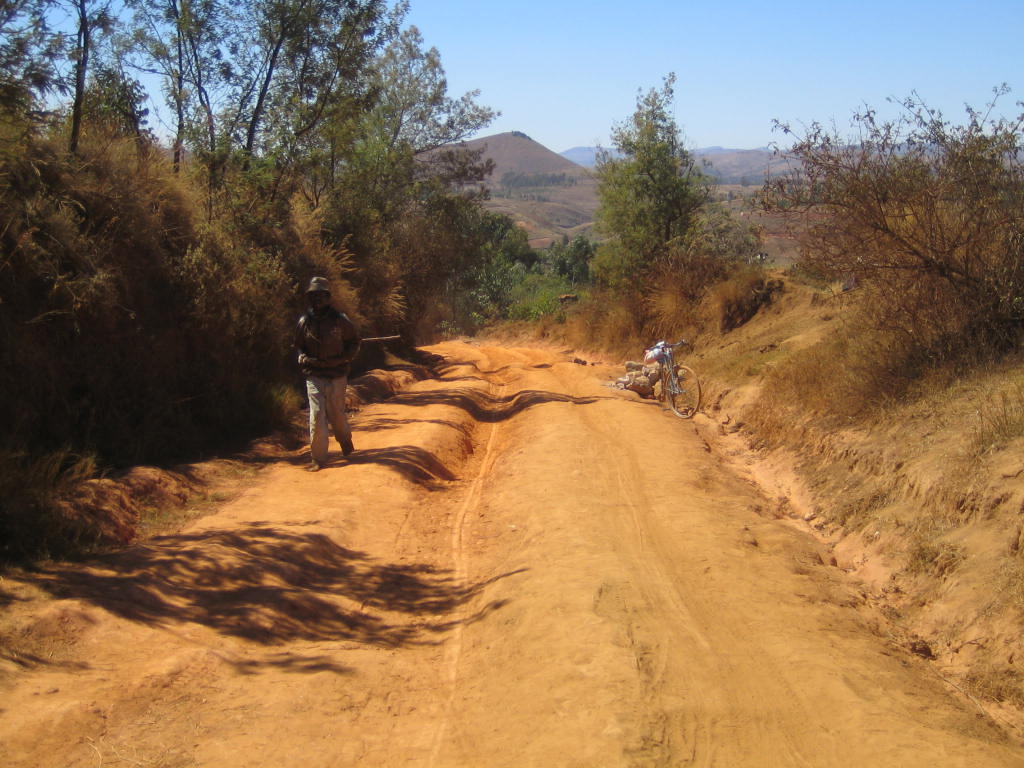
But that wasn’t the case; on the contrary, it only got worse. What surprised me was that no one was surprised that I wanted to go that way, especially with all my luggage. They just remarked that I could get through there on my bike. Nothing else but bikes could get through there, not even ox carts. The “road” is really a challenge. Deep washouts, bare rock in places, which was the more pleasant part, but also sand, gravel, and mud. On top of that, it was quite mountainous here. It took me at least six hours to cover the next 30 km! I fell twice. Riding on the washout was risky because it was too narrow and too sandy. I kept slipping. The rut was too narrow and too deep, so I kept getting stuck with my panniers and pedals. For a while, I was able to follow another cyclist who knew the best way to meander through. Of course, without any luggage, he was much more maneuverable than I was. With a light mountain bike, the route would certainly have been fun. A guy helped me push my bike up a section that was really impassable. Halfway there, two children told me there was a detour. I then asked the cyclist to ride with me until I was back on the “official road.” Even if the route is completely impassable and there is no village in sight, you are still rarely really alone. At some point, somewhere, someone always shows up, on foot or by bike. That’s why I didn’t have any major concerns, even though the ride wasn’t without danger. The great thing about the route is the landscape. The mountains are simply magnificent. In the middle is a river valley, and rice terraces have been created on the hills. The people here have not yet been spoiled by tourism, and hopefully they won’t be after me either. I didn’t get the impression that “vazahas” (strangers, white people) often pass through here.
I realized pretty quickly that I wouldn’t make it to Faratsiho. It was already quite late, there was no prospect of the road conditions improving, and because of the rough contacts with the pedal, my right calf looked like it had been put through a meat grinder. The area was extremely unsuitable for camping. On one side of the “road” it went steeply uphill, on the other steeply downhill. The real problem was water, which was slowly running out. The heat and dust didn’t exactly contribute to my well-being either. But if I’ve learned one thing on my tours, it’s that despair doesn’t help at all, it just costs unnecessary energy. The important thing is not to lose confidence that you can do it.
How relieved I was when a farm suddenly appeared. Even if it didn’t look particularly inviting, it was the first sign of civilization. Full of optimism, I rode on to see what else was coming. And sure enough, after the bend, a church tower suddenly appeared. It was clear to me: I would go to the village and not a meter further. As usual, I was greeted by a horde of schoolchildren: “Salut Vazaha” echoed from all corners. It’s probably not often that a Vazaha passes by here, especially not on a bicycle and wearing a helmet. Later, the teacher told me that two Frenchmen had passed by on bicycles last year. So this route is not very frequented. Nevertheless, I was surprised that there are still such crazy people. This teacher also convinced me that it would be better to spend the night in the village. Of course, it didn’t take him long to do so. After a tour, I found a nice spot at the Centre de Santé, in the “garden” of the Chef of the Centre.
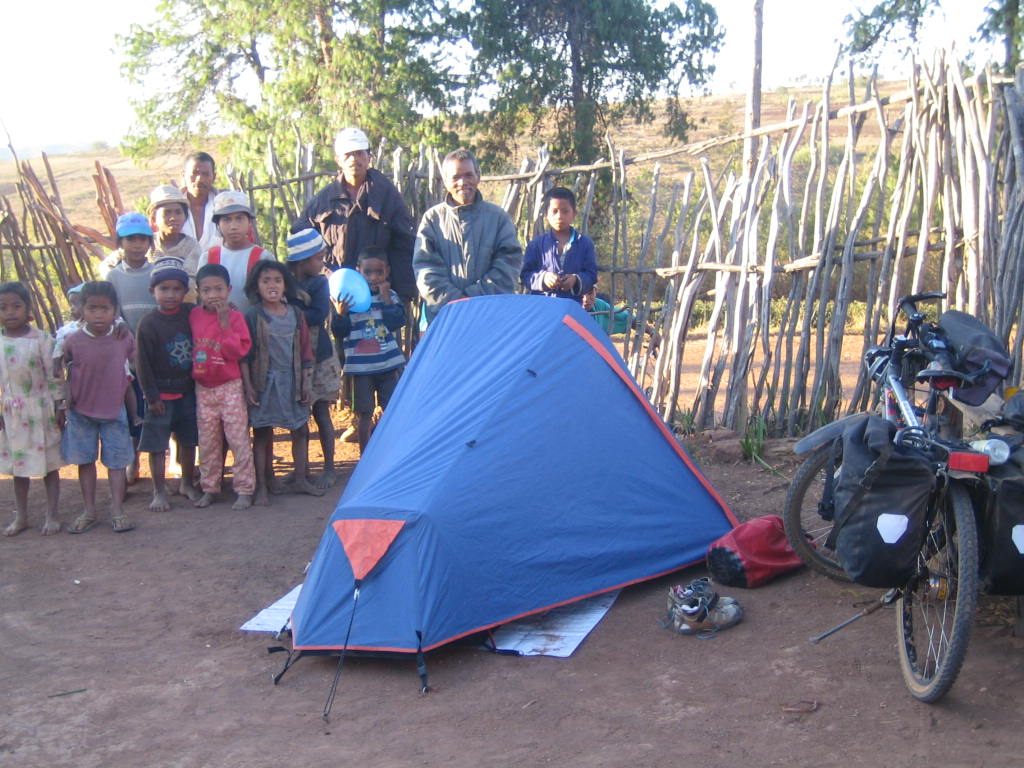
In the remotest corners, there are no hospitals, but rather these centers that are connected to the hospitals. I also don’t believe that the bosses are really doctors. Which isn’t really necessary anyway, since there are no sick people. A few years ago, they apparently had a few cases of plague.
That’s why they were able to offer me a room, but I preferred my tent. Since this is a health center, I thought they would place a little more emphasis on hygiene, so I asked for a toilet. Unfortunately, the little house was swept away by a hurricane last year and has not yet been rebuilt. So, back out into the great outdoors—luckily, there are no poisonous snakes here.
There was water too, but not from a bottle, rather from the well. With Micropur, it is drinkable for me as well. The “store” didn’t open until later, when the owner came up from Faratsiho with his ox cart. All they had was an old baguette. It was OK with my instant soup. I didn’t want to be invited in by the boss and his wife. As usual, they had a horde of children, and since they weren’t expecting me to show up, I didn’t want to eat anyone’s food.
In the evening, the balloons I brought with me were once again a big hit.
Sambaina 73 km Friday, September 29, 2006
What a feeling to have solid ground under my wheels again. It makes a huge difference. Unfortunately, people are different again, but I was lucky here once more. My tent is pitched in the yard between potatoes, charcoal, and chickens, much to the amusement of the old woman. She keeps peeking around the corner, laughing and shaking her head. She’s probably never seen anything like this before.
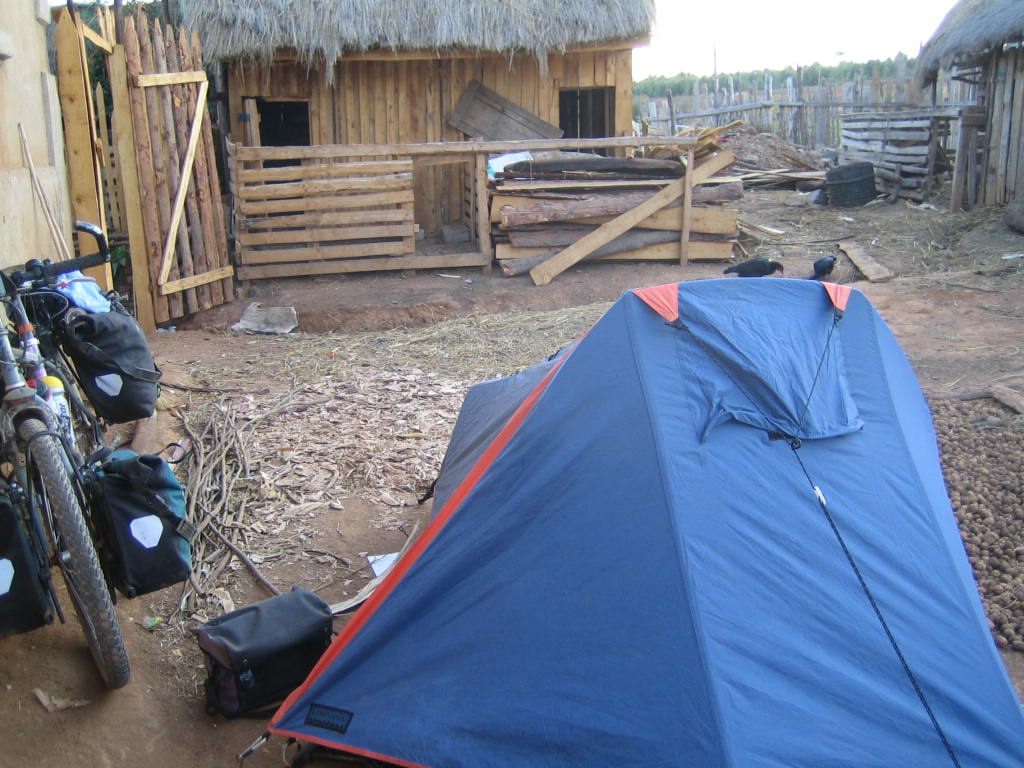
This morning, after a hearty breakfast and farewell photos with the boss and his family, the teacher reappeared with the whole group of children to wish me well—and, of course, to remind me to take their address with me, which is always very important. Finally, they got me a guide to help me push my bike up to the next summit. After yesterday’s strains, I found that very nice; I could easily accept it despite my sporting ambition. But it wasn’t as bad as yesterday, the path was much better. At the beginning, it was a beautiful coniferous forest path. The whole area became gentler again, no longer so steep and rocky. Although there is really nothing there—no roads, no towns, nothing—there were quite a few people on the road, mostly on foot. If only I knew where they were all going! It’s about 30 km to the next village.
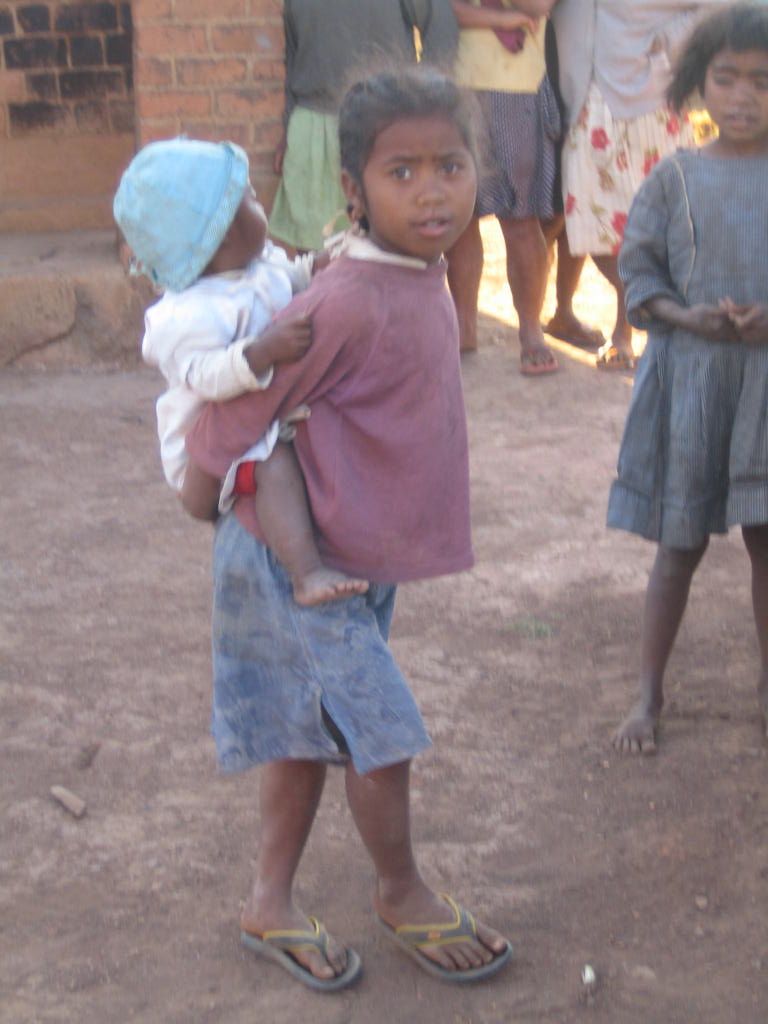
I was very grateful to the guide. We had to cross rivers twice. My shoes look accordingly. Even with him, it took me four hours to cover the 25 km. In the end, he not only accompanied me to the summit, but all the way to Faratsiho. I couldn’t even say which summit they meant first; there were several more to come. As is always the case, when it’s most exhausting, it’s also the most beautiful. It was simply brilliant. All the hardships were worth it. Now I’m just afraid that the paved roads will be too boring. From Faratsiho, four-wheel drive vehicles are used again – a sign that it can’t be that difficult anymore.
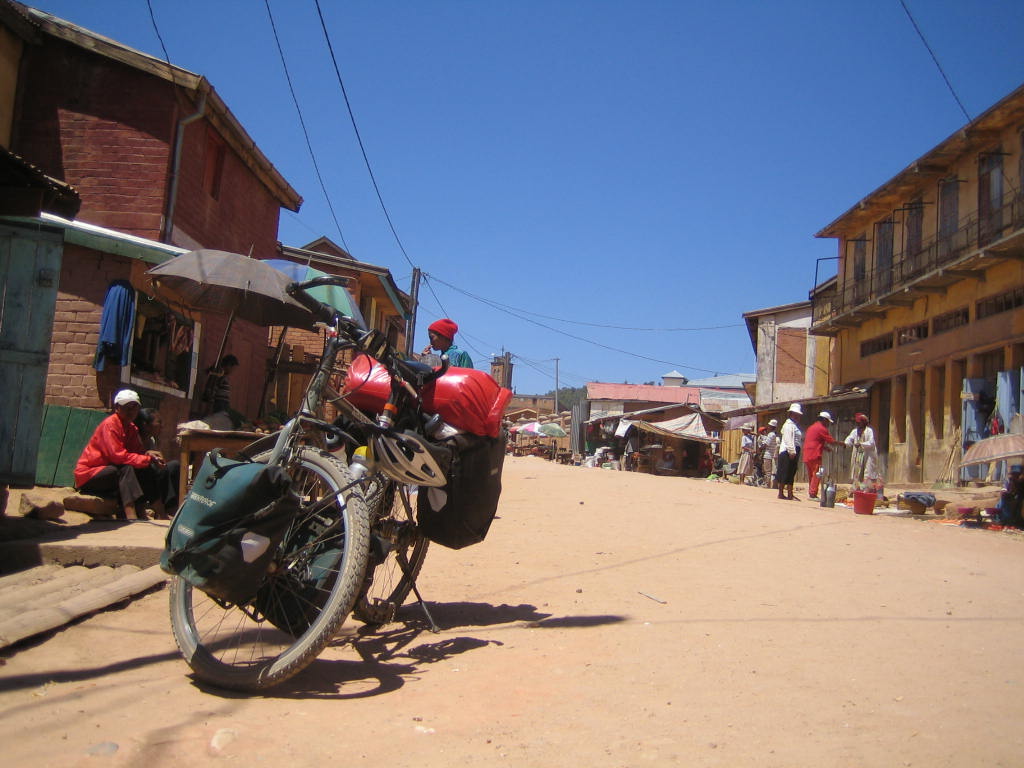
After regaining my strength—drinking real water from a bottle followed by a Coke—I continued on my way. I rode along leisurely and only noticed after a while that it was constantly uphill. I was now at an altitude of over 2000 m. When you’re lost in thought and there’s something to look at, you ride along mechanically. This way, you can climb most mountains without any major problems, not quickly, but without effort. Here, I was also able to listen to a shepherd boy. While they herd their zebus, they play the flute. Unfortunately, I haven’t seen it up close yet; I really liked the melody, and the mountains also have good acoustics.
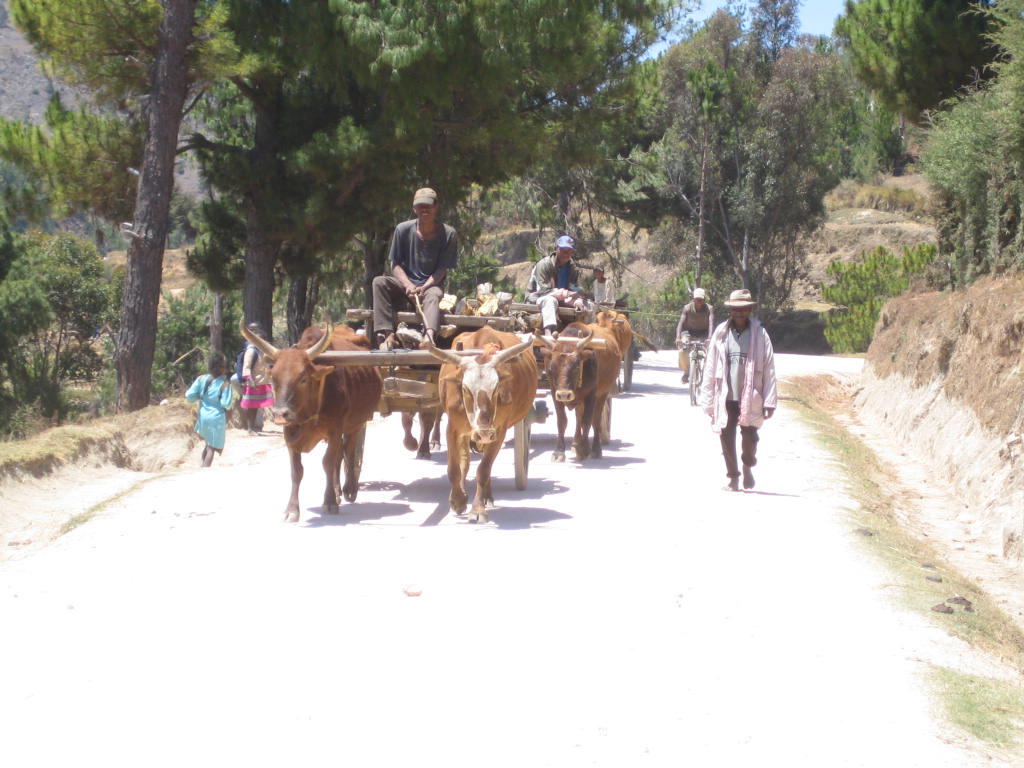
I wasn’t far from Faratsiho when two large motorcycles came towards me. A German couple, the first white people I had seen since Tana. They actually wanted to ride the route I had just completed in the other direction. They had the same map. As usual, we exchanged experiences during such encounters, which resulted in them turning back and me continuing on my way full of confidence. Apparently, the roads I want to ride on are more passable.
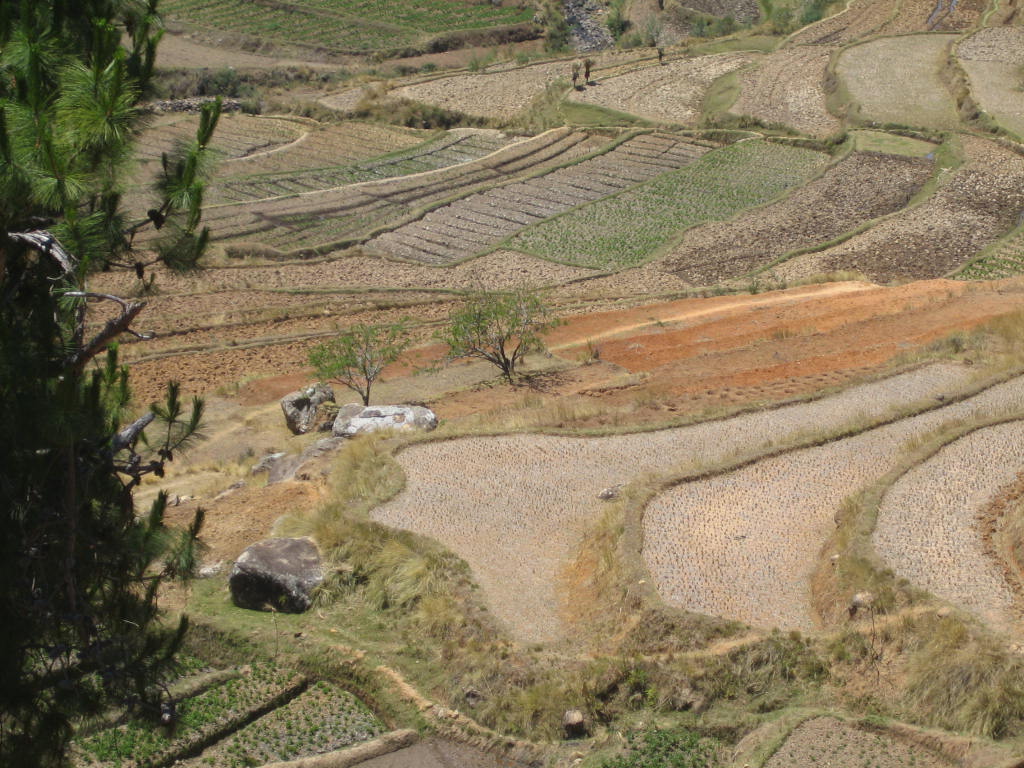

At some point, I reached the top, then rounded a bend and saw the whole magnificent view before me: just downhill into the wide valley to Sambaina, where the road meets the RN 7, Madagascar’s “highway.” When I reached Sambaina, I knew: I’ve had enough for today, I don’t want to go any further. Unfortunately, the place didn’t look very inviting, and it wasn’t. Only one woman in a hotely looked quite nice. I asked her if she knew of a place where I could pitch my tent. After thinking about it for a while, because the yard was so dirty – not to mention me – my tent is now pitched between chickens and potatoes. A hotely is not a hotel, but just a place where you can always get coffee and other drinks, and usually something to eat, but normally no room. That’s how I ended up having my first real Madagascan dinner: rice with chicken. They even gave me the rice water, which they also drink, but I didn’t particularly like it.
Antsirabe 36 km Saturday, September 30, 2006
What a life. While I was having breakfast, I watched the son of the house. An extremely handsome young man, maybe fifteen or sixteen years old, who doesn’t look stupid at all. He’s been hanging around for some time now. Probably no school today, because I know he’s one of the few exceptions who actually go there.
As I sat there watching him do nothing, I suddenly felt very tired. I am the complete opposite: savoring every minute, never standing still. Maybe I should learn from this mentality. From what I’ve read about the Madagascans, they don’t need to achieve anything in this life, because real life comes after it. I think it’s time for me to slow down—you can’t achieve everything in one lifetime.
When I got on my bike, I had a slump and was terribly tired. I barely managed the 36 km to Antsirabe, even though it was a paved road, there were no significant hills, and I wasn’t struggling with headwinds. The only reason I could think of was that I hadn’t slept well the night before. It was quite noisy. There weren’t many cars, but when one did come along, you were almost standing upright in your sleeping bag (if the tent had been taller). There are also lots of dogs here, which seem to be nocturnal. They have to bark at each other.
All in all, my condition told me: now it’s time to pamper myself a little. So I was satisfied with the 36 km, because this is a larger city with proper shops where you can buy something to eat and good accommodation options. I actually wanted to camp in Green Park, but since pampering was the order of the day, I opted for a pavilion with a proper toilet and a proper shower, even with hot water.
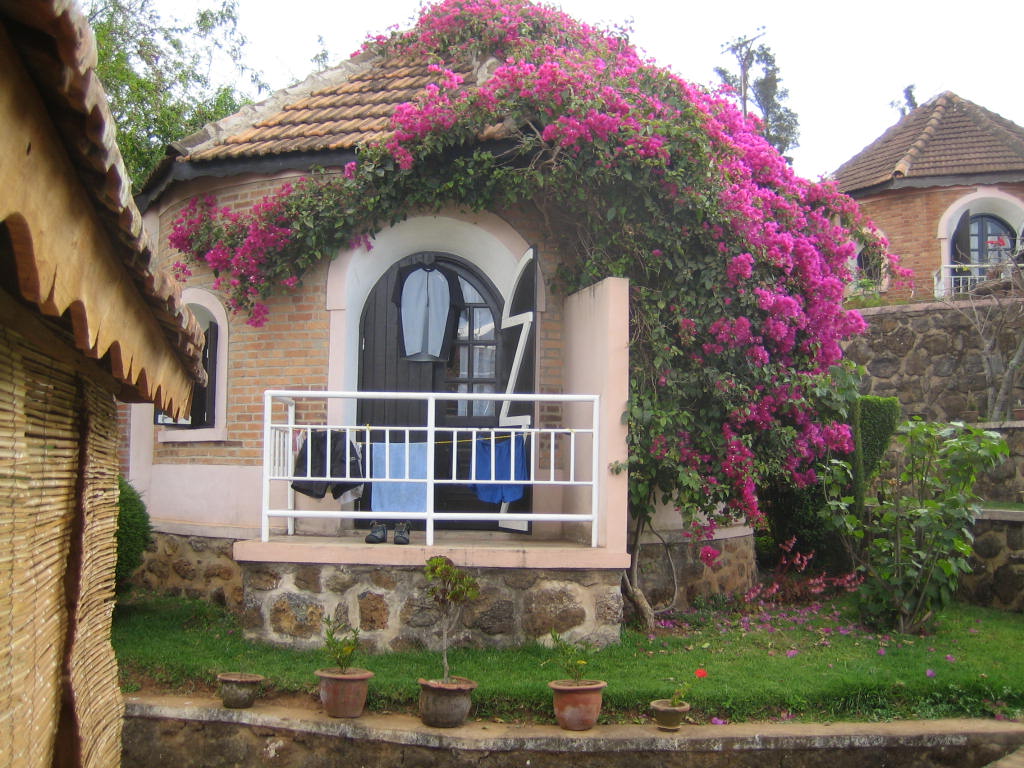
After spending several days in the wilderness, this was quite appropriate. My clothes and shoes were washed, and my bicycle was repaired. Since it was only 10 a.m. when I moved into the cottage, I was able to make the most out of it.
I am not particularly fond of the city itself. There is a lot of poverty and hunger here, even though there is plenty of food. The market is overflowing.
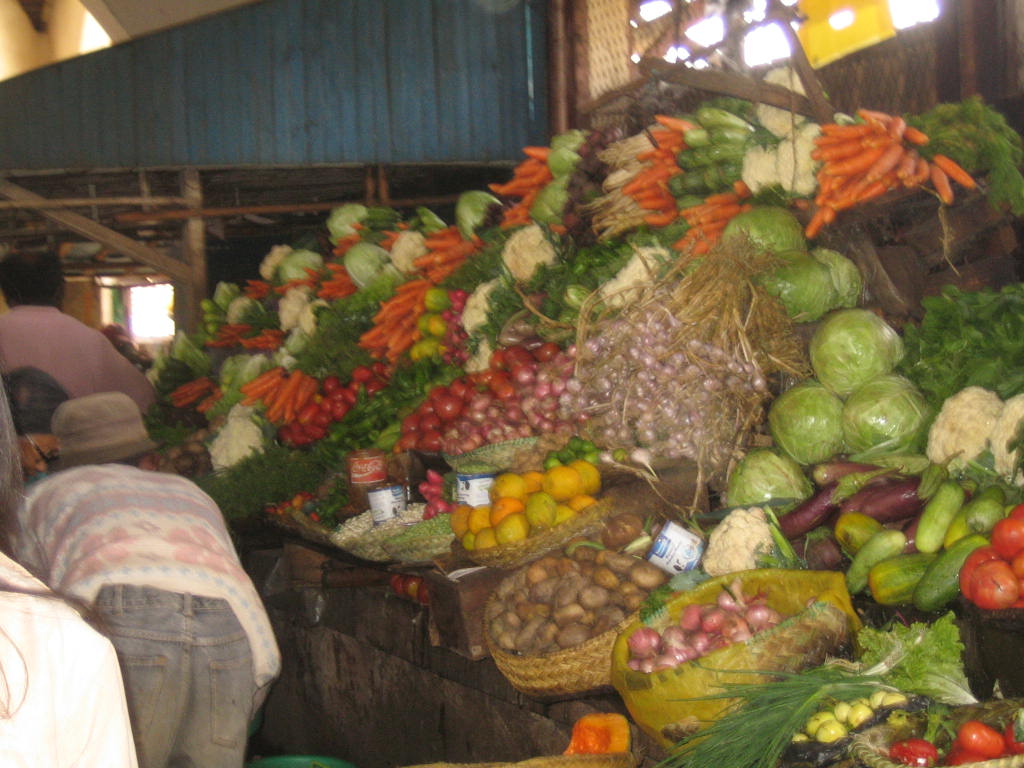
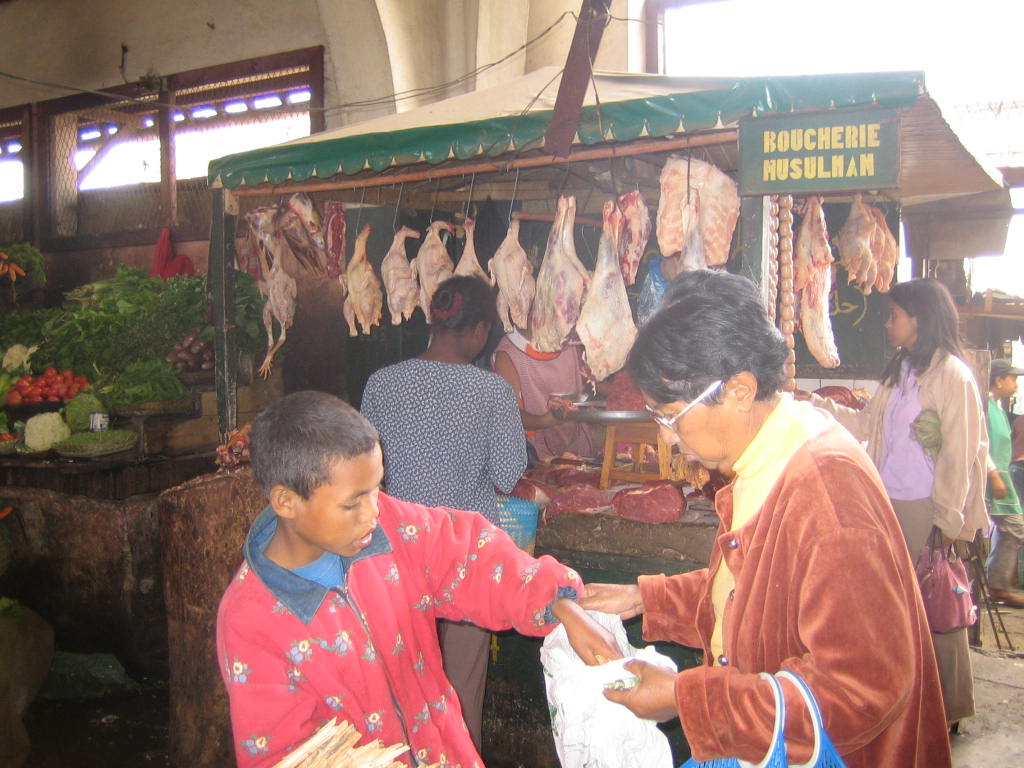
Today, I can’t stand how they all want something from me, even the pousse-pousse drivers. That’s even worse than rickshaws, with them running around barefoot. Since I just wanted to relax anyway, which is easy to do in the garden, I avoided the city as much as possible.
Mandoto 106 km Sunday, October 01, 2006
When I arrive, some villages are like a school yard during the break. They are bursting with children. If one of them sees me from afar and shouts “Vazaha,” the hustle and bustle begins. They come crawling out from all corners. Even if there are only three huts, there are sure to be 15 children. But hardly any of them dare to come near me; the fewer children there are, the greater the safety distance. Very small children also run away screaming.
With all the attention I caused, I actually thought that not so many vazahas pass through here. I don’t see any either. If they’re not flying from one attraction to another by plane, they race through the villages in four-wheel drive cars, invisible to the inhabitants. Here in the city, you seem to see travelers more often. That’s fine, because then I have my peace and quiet.
When I went back to the village to get a “shandy” – yes, they really do have them here, they’re actually called “Panaché” like in France, but there’s only one brand: Fresh – I saw why. This is where the taxi brousse, or bush taxis, stop. These are Japanese cars, small buses, crammed full of people, probably still alive at the start of the journey, with all kinds of luggage piled on the roof, e.g., a whole stack of bicycles. Here in this place, the passengers are allowed to stretch their legs. So today I saw my first tourist (apart from the one in the mirror this morning – yes, I had a mirror). I’m quite happy about what I’m not doing. I’d rather ride a bike.
My tent is in the “garden,” a mixture of stone and sand, belonging to a hotel. There are a few small huts around that you can rent, but I doubt they offer any more comfort. At least in my tent I know I don’t have any “roommates” and I can see the gigantic starry sky. Apparently there were two cyclists here last night, so I’m not the only one after all.
Otherwise, today was another brilliant cycling route, especially the first and last 30 km. In between, it was quite hilly and very warm. I now realize that I have lost quite a bit of altitude, it is quite late and not cool at all – the first time without a sweater.
Miandrivazo 120 km Monday, October 02, 2006
What a stressful day, and on top of that, I overslept. But it was probably for the best. I needed the sleep. Last night, there was some kind of event in the village that went on until late. Probably so that not everyone had to come out of their huts to the market square, they broadcast the whole thing over loudspeakers. It was certainly very interesting; the guy really had a lot to say, but unfortunately I didn’t understand a word and wondered why they had to make so much noise.
I’ve probably already mentioned that my daily rhythm has adjusted to the sun. I usually go into my tent at 7 p.m., when it’s already dark, and by 8 p.m. I’m actually asleep. Apparently, I was the only one with this noble desire yesterday. This speech was certainly very important, but definitely not a bedtime story. Not even earplugs helped. So it was quite good that I caught up on my sleep this morning. Apparently, the roosters did the same, as they usually wake me up at 5:00 a.m. at the latest.
So it was quite a close call. 120 km isn’t much, but with 45 km of constant uphill and downhill riding under the African sun, which was particularly noticeable today, it’s no walk in the park.
This is supposed to be the hottest city on the island, which has been noticeable for quite some time. It wasn’t very pleasant. The air in my rear tire had also had enough and escaped. Understandable, really, as it’s certainly even hotter inside the black tire. But I had to pump it up four times, which wasn’t very cooling either.
But like every day, today there was a moment that made all the effort worthwhile. This time it was even quite long. First of all, after I had passed through Kiranomena, I had the whole wide valley below me.
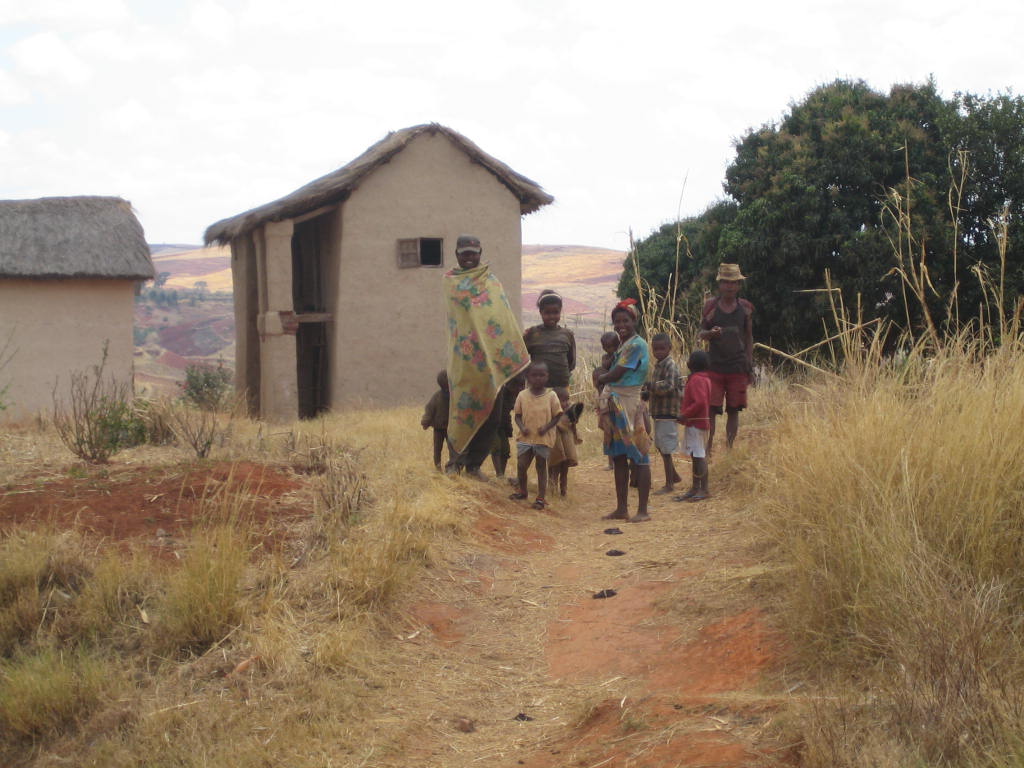
It was a steep 27 km descent to Miandrivazo.
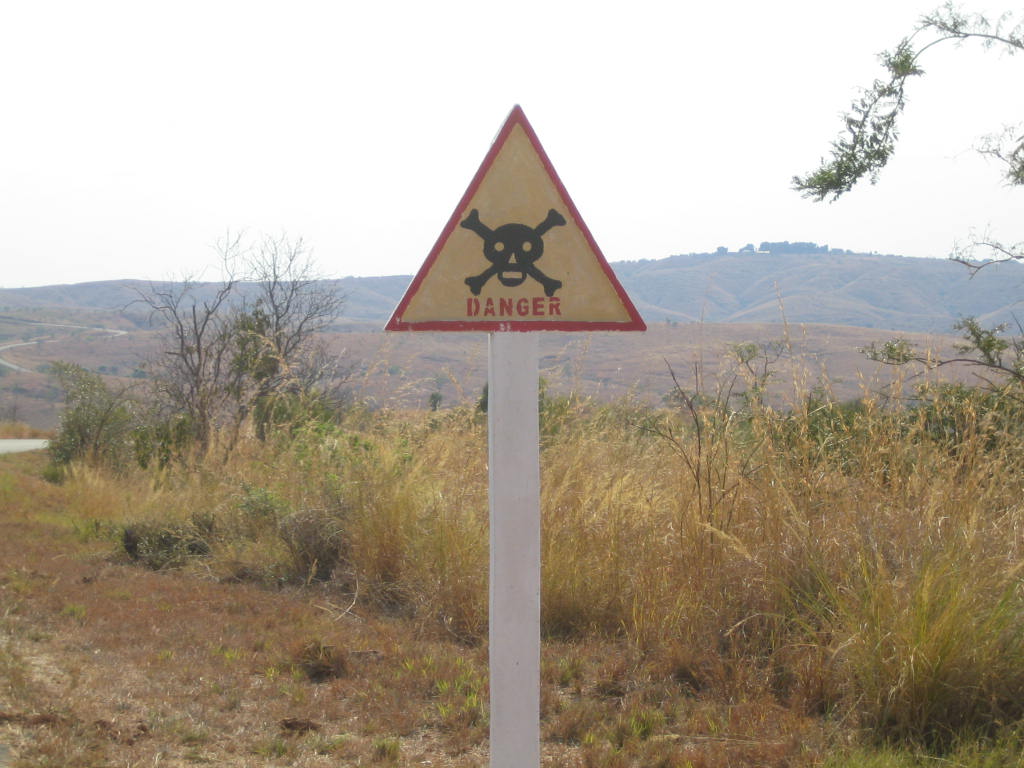
When I arrived in town, I wanted to buy something cool to drink, as usual. But my shoe wouldn’t come off the pedal. To everyone’s amusement, I had to get out of my shoe. A screw had come loose from the cleats. That’s why the cleats remained firmly in the pedal despite the rotation of the shoe. The main thing was to get something cool to drink, and nothing else mattered. Since I didn’t feel like pitching my tent, I looked for a hotel.
As this is almost a tourist village, it wasn’t that difficult. At the foot of the hotel hill, two young men were already waiting to push my bike up. “What nice guys,” I thought, “I’ll tell them I don’t need guides once my bike is at the top.” Tourists actually only come here to start a boat (pirogue) tour on the Tsiribihina to Belo. That’s out of the question for me, if only because the whole thing takes three days. I wouldn’t even last a day in a boat like that. But the boys couldn’t know that – not yet. In fact, that was their concern; they took care of me simply because they assumed I was like all other white people. But unfortunately, I prefer my bike. They walked away, slightly annoyed.
A room like this really takes some getting used to. In a tent, you become a real fresh air fanatic. But a closed room like this is not only airtight, it’s also sightproof. At least here I could repair my bike in peace and fix my shoe, which had come loose from the pedal. But now a screw is missing, so I have to ride without clipping in. The shower and toilet are in the hallway. Luckily, there are several showers, as one was already occupied – by a frog. No, I didn’t kiss it or throw it against the wall. I wouldn’t know what to do with a prince anyway.
Since Sambaina, the roads have been more or less paved. But today I asked myself why. There are hardly any cars, and if there are, they are bush taxis or SUVs with drivers and tourists. The majority of the population can’t afford a car anyway. The Madagascans populate the streets on foot or with zebu cars (ox carts), and few have bicycles. You really don’t need paved roads for that. But tomorrow we’ll continue on unpaved roads.
10 km vor Mailambandy 101 km Tuesday, October 03, 2006
It’s beautiful here now. The light at dusk is truly African, and there’s a lovely cool breeze. The rustling of the leaves is the only sound far and wide. After having to plug my ears for the last two nights, I decided to spend this night far away from any generators or animals. My campsite is not far from the road. Apparently, there aren’t even any huts nearby, as I haven’t seen any pedestrians. After this relentless heat, I can really enjoy the evening atmosphere and coolness. The sunset is gorgeous, as always.
Today, I actually met my first “travel cyclist.” A Frenchman who has been living in Madagascar for some time and is quickly racing across the island on his mountain bike. He only had a small backpack as luggage. Instead, he had a companion on a scooter. I call that cheating. Still, it was nice to have company for a few kilometers. Of course, I was much too slow for him, and he sped off. But I can pitch my tent wherever I want.
Shortly after, two local boys on bicycles took me in. Without any prior agreement, they took care of me. I really enjoyed it and was grateful to them for it. This probably also has to do with the extraordinary hospitality. These guys know the way inside out. If you ride right behind them, you avoid suddenly ending up in a sand hole. I can do without such abrupt stops. Even though we couldn’t talk to each other—they were far too young to know French—it was natural to wait for each other. This went on for a few hours, about 70 km. Unfortunately, they stayed in Ambatolahy. Although they didn’t ask for anything and I don’t usually give money as gifts, I gave them something. Not only did it help me a lot, but it was also really fun.

I took a break in the village first. It was definitely 40 degrees. After that, I could hardly continue riding. Really Australian temperatures, but at least there’s shade here. The first, most delicious yogurt “à la maison” also helped me get going again. As far as I can remember, I polished off two of them.
Due to the poor “road conditions,” I mistakenly assumed that no cars would pass by at night. But I was proven wrong. Why not take advantage of the cool night air? You can’t drive into the ditch because you’re already there—the whole road consists of ditches.
Although a few cars passed by during the night and I can hardly imagine that they hadn’t seen my tent at all, no one was interested in me. In an emergency, I would have had my pepper spray. I don’t know how much good that would have done in the middle of nowhere, but I was far too tired to think about it.
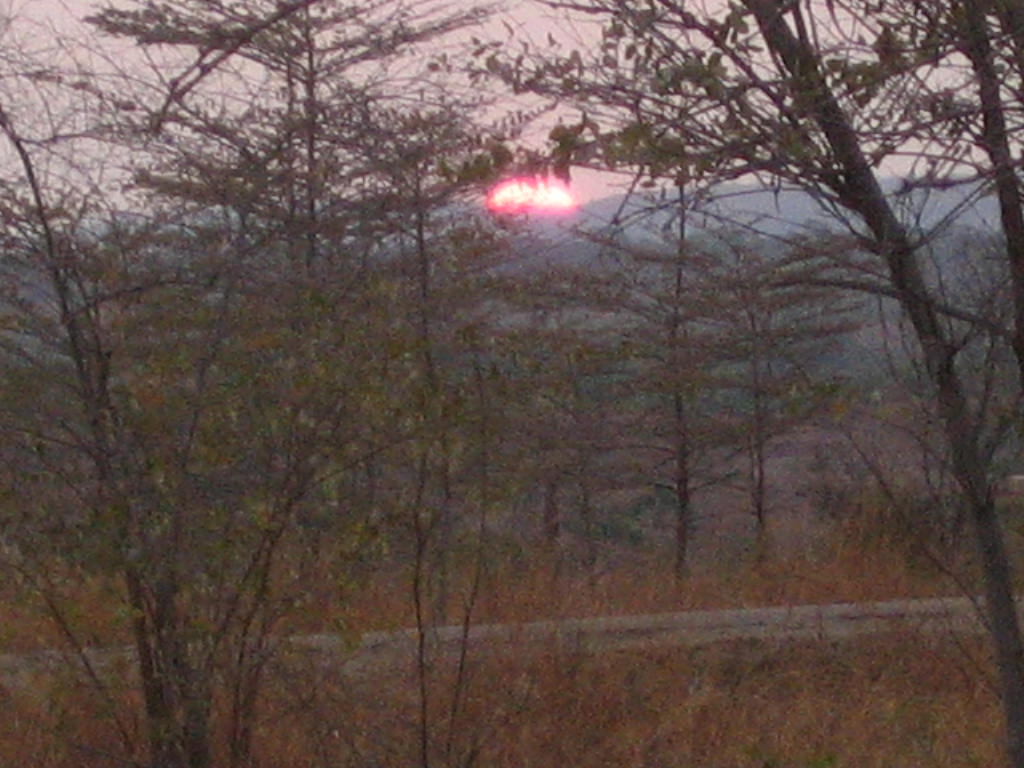
It’s not that quiet in the great outdoors at night. Even if there are no generators, there are still nocturnal creatures, such as one that makes noises like dropping a ping-pong ball on a table. Since this didn’t lure me out of my tent, I still don’t know whether it was a bird or some other creature.
Ankilizato (77 km) Wednesday, October 04, 2006
My first fall—and what a spectacular one! Of course, I waited until I had enough spectators: a bush taxi was behind me at a safe distance.
The screws on my front pannier rack had come loose and everything got tangled up in the spokes, causing the front wheel to come to an abrupt halt and the rear wheel to overtake it vertically. I was somewhere in between. Miraculously, not much actually happened! Thanks to the helmet and gloves that I always wear, despite the heat. I know from experience that my attention and riding skills are not always to be trusted. So there I was, wondering how quickly you can get off your bike. Sand on the “road” can sometimes be an advantage. The result of the story: a bump and a slight scratch on my chin and a graze on my left hand, which was also swollen, so that my glove hardly fit anymore.
The whole thing happened on the last stretch of the gravel road, about 30 minutes after setting off this morning.
After hearing the first pedestrians marching past at 10 minutes past 5 a.m. (once again, one can ask in vain where they are coming from and where they are going – both times it is from/to nowhere), I knew it was time to pack up. I didn’t make myself a coffee, as I had nothing to eat, but I knew there were a few food stalls not far away. No problem so far, and after a fantastic sunrise, the sun was back, but it spared me from the heat. After half an hour, I took the break mentioned above.
The passengers in the taxi brousse were more shocked than I was – after all, I didn’t have to watch myself fly through the air. They quickly got out and checked to see if I was okay. They also wondered where I had come from so early in the morning. Apparently, they thought I had been cycling through the night and that total exhaustion was the reason for the fall. Far from it. I said the only thing I needed was a coffee. That made them curious; they wanted to know where I had slept. They could hardly believe that I had camped in the wild and survived not only the crash but also that. Apparently, this is one of the most dangerous areas in Madagascar. Taxis apparently only travel in pairs on this route.
I had already read about the “Zone Rouge.” There are supposed to be quite a few bandits there. But they mainly target zebus, so I felt relatively safe. Besides, I didn’t know that this area was part of it. When I arrive by bike, a vazaha with a helmet, the locals are far too astonished to harm me. Taxis are much more common and look more like money. I don’t think any Madagascan can imagine voluntarily cycling across the island when they have enough money to use other means of transport. Rarely have I felt as safe as I do on my bike on the island.
But back to my fall. My bike proved once again that it is indestructible. Not a single spoke was even slightly bent, even though the front luggage rack had twisted through it. Actually, only one screw was missing, and I even had a spare. The taxi driver made sure that everything was tightened securely, and the female member of the crew took care of my physical well-being. When they felt I could be left alone again, they drove off.
I then only had a few kilometers to go to the paved road, where I could also get coffee. Unfortunately, the selection wasn’t very extensive and the coffee was terrible, but it was enough to survive. The main thing was that I could stock up on water again.
The selection wasn’t much better along the entire route to Ankilizato. Once, I passed a stand selling mangoes. They weren’t used to seeing me either. The small children ran away screaming. Nevertheless, I stopped and ate a few mangoes. The people were sitting under the stand because of the heat.
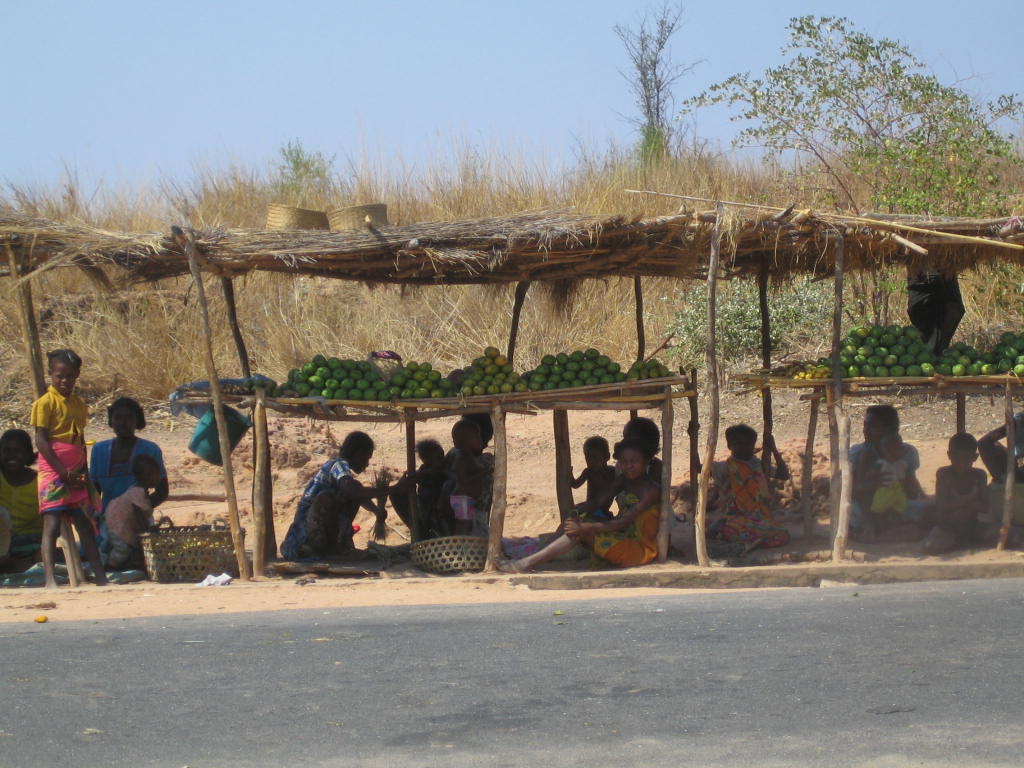
I sat down under a tree. Slowly, the children also became convinced that I was a human being. After giving them my empty water bottles, which they are always very happy to receive, I cycled on. But because of the heat, I stopped at every opportunity. I was probably the first white person to appear here in a long time, and then to stop as well. No one spoke French, so we just stared at each other. Once, I came to a village, which consisted of a few straw huts with a large tree in the middle, in whose shade I settled down. Soon I was surrounded by extremely young mothers with their babies and a few young boys, who were probably the fathers.
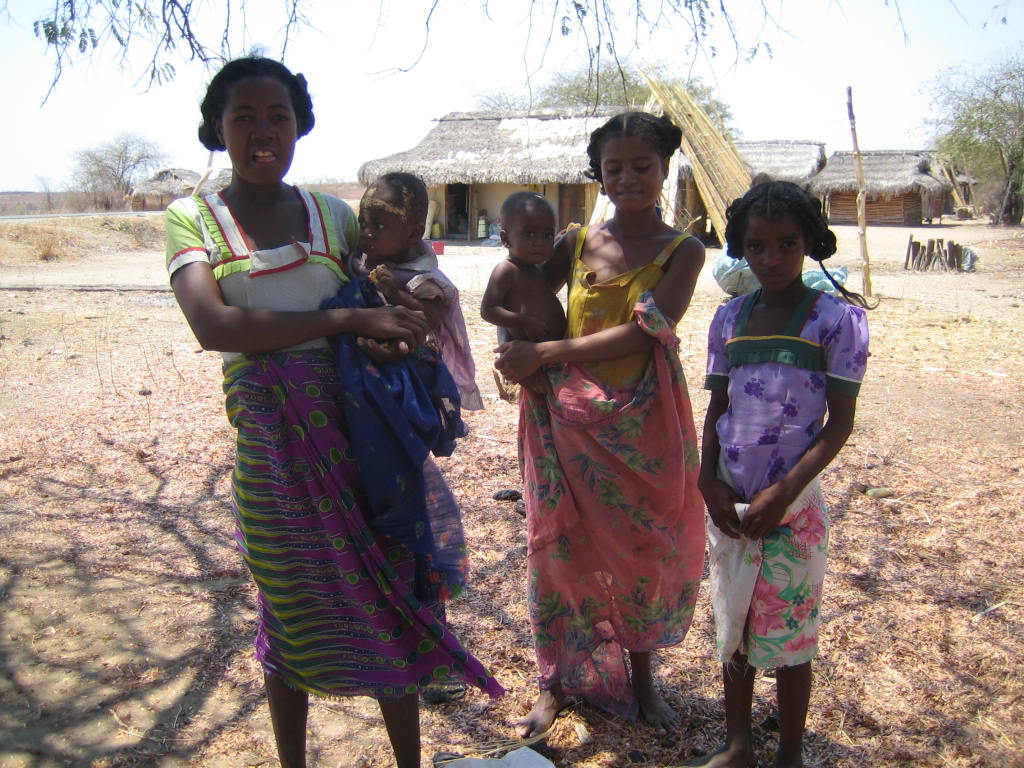
They had a young goat in a sack, which they treated quite roughly. They were probably on their way to kill it. When they noticed my astonishment, they threw the poor animal around even more and laughed. I just thought that maybe this was also part of their survival strategy. Many men here have replaced their canine teeth with gold teeth, and the women have glittery pieces between their incisors – a kind of “tooth piercing.”
I made my next stop at a school building. Of course, there were no classes again. Two blackboards had been set up in one classroom. Both had today’s date on them, but one was in French and the other in Malagasy. None of the students who were still standing around spoke a word of French.

I arrived in Ankilizato quite early, but nothing in the world could have persuaded me to continue my journey. First of all, I treated myself to a cool Coke and lemonade at the bar, surrounded once again by millions of children.

I arrived in Ankilizato quite early, but nothing in the world could have persuaded me to continue my journey. First of all, I treated myself to a cool Coke and lemonade at the bar, surrounded once again by millions of children.
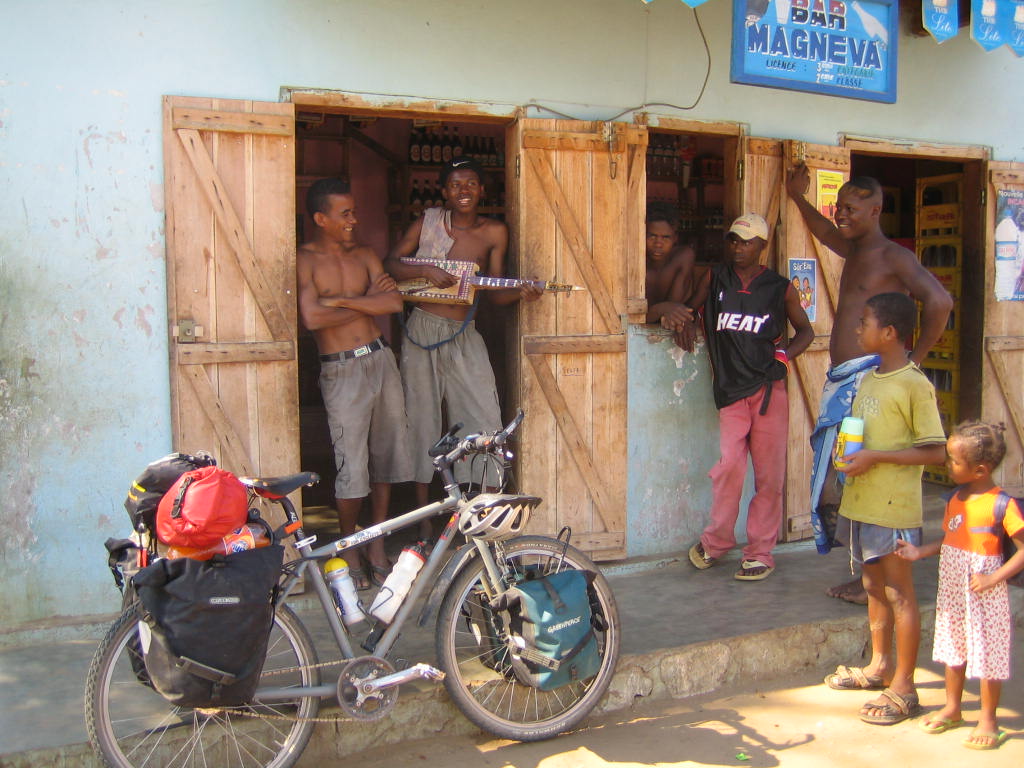
After last night’s inexpensive stay, I took a room here that has everything I missed last night: the generator, dogs and roosters, and of course the heat under the corrugated iron roof. In return, a little boy proudly carried two buckets full of water into my room for my “bucket shower.”
The girl who lived in the house told me that the French people I had met the day before had stayed here the night before. They had already told her I was coming.
Morondava 104 km Thursday, October 05, 2006
Finally at the baobabs. The last stage was beautiful. After the last hill, the area became quite humid; there is plenty of food growing everywhere, mainly bananas and rice. The Madagascans really don’t need paved roads here, except perhaps for the tourists.
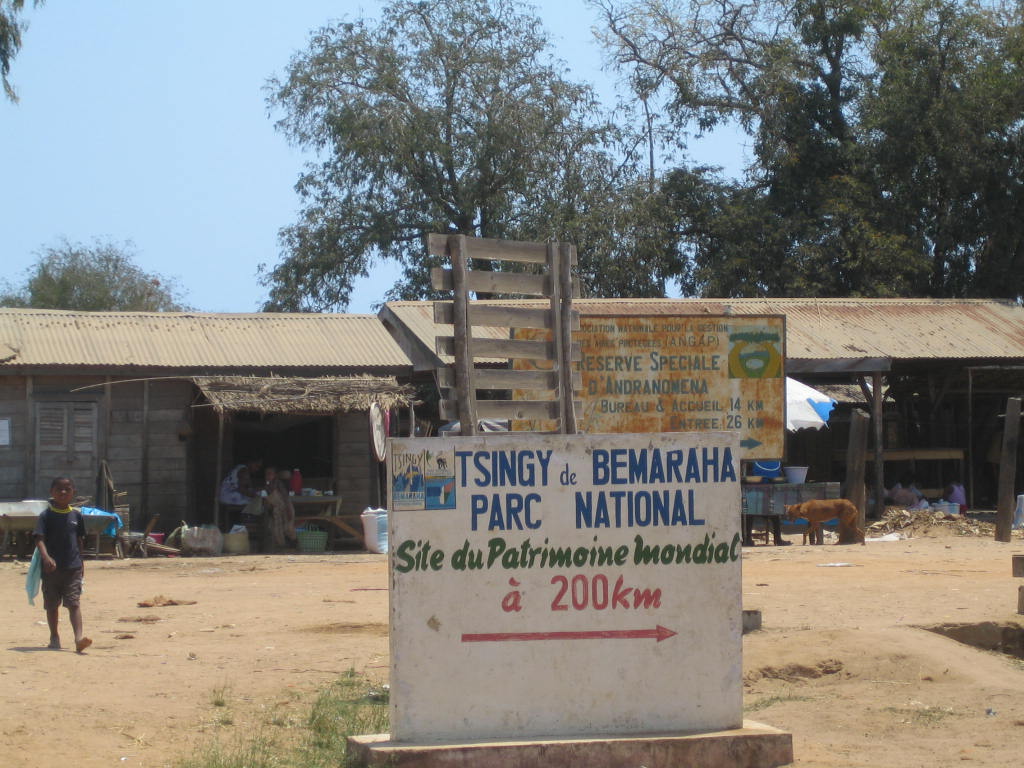
I actually wanted to do a statistical survey of how many cars I see per hour, but when the next car came six minutes after the first one, I gave up. That ruined the whole statistic. Except here in Morondava, traffic cannot be counted among the stress factors. Today, it wasn’t the mountains or the heat either; at most, I could complain about the headwind, but it wasn’t that bad.
The condition of the road cannot be described as paved throughout; that may have been the case years ago. I find it reassuring that nature is reclaiming its place over time.
So I trotted along here between bananas, mangoes, rice, and children bathing. Cycling isn’t exactly popular here in the city. There is at least 20 cm of sand on all the roads. I had to push my bike 1.5 km to my hotel.

That couldn’t upset me anymore. It’s in a very beautiful and quiet location between the canal and the sea. So you can watch the freshwater pirogues on one side and the saltwater pirogues on the other. How interesting! I’m staying here until Monday, then I’m flying on to Toliara (Tulear); I already have the ticket. First, I’ll rest here and then do a bit of sightseeing.
Morondava 0 km Friday, October 6, 2006
0 km – that sounds like a day of rest. It was – almost. At least for the bike. It stayed in the room the whole time. I, on the other hand, walked around quite a bit. But first I slept in. Even though the “journey” to the hotel was quite exhausting, it is so nice and quiet here that it was definitely worth it. Quiet and relatively cool, really relaxing. Even the roosters don’t crow until 6 a.m.

Here’s the reason to complain: the coffee is terrible! The only milk available is condensed milk, which is quite sweet. You’re used to that kind of thing on the street, but the quality is usually better in hotels.
I knew I’d be eating my way through the city again, so breakfast wasn’t that important to me. At the bank, I got another stack of bills. Most of it goes into a plastic bag, a small portion into my wallet, and the small, filthy, greasy, dirty ones into my pants pocket. There are no coins. 100 ariary is 4 cents. These bills are thrown around everywhere, look accordingly, and stink. It’s actually frightening what you can get for that amount. Eating your way through the country is quite cheap, at least for Europeans.
The tours to Parc Kirindy were not so convincing! After careful consideration, I came to the conclusion that it would be better to stay there overnight and that the best way to get there would be by bike. Since I can leave most of my luggage at the hotel, it will be a pleasure trip.
Then I thought I should contact home and sat down in a cyber café. Yes, there are such places here in this tourist resort. But there was probably a glitch, because after 10 minutes my mailbox still wasn’t open, so I left without having achieved anything. I spent the rest of the day really on vacation, sleeping, reading, listening to music.
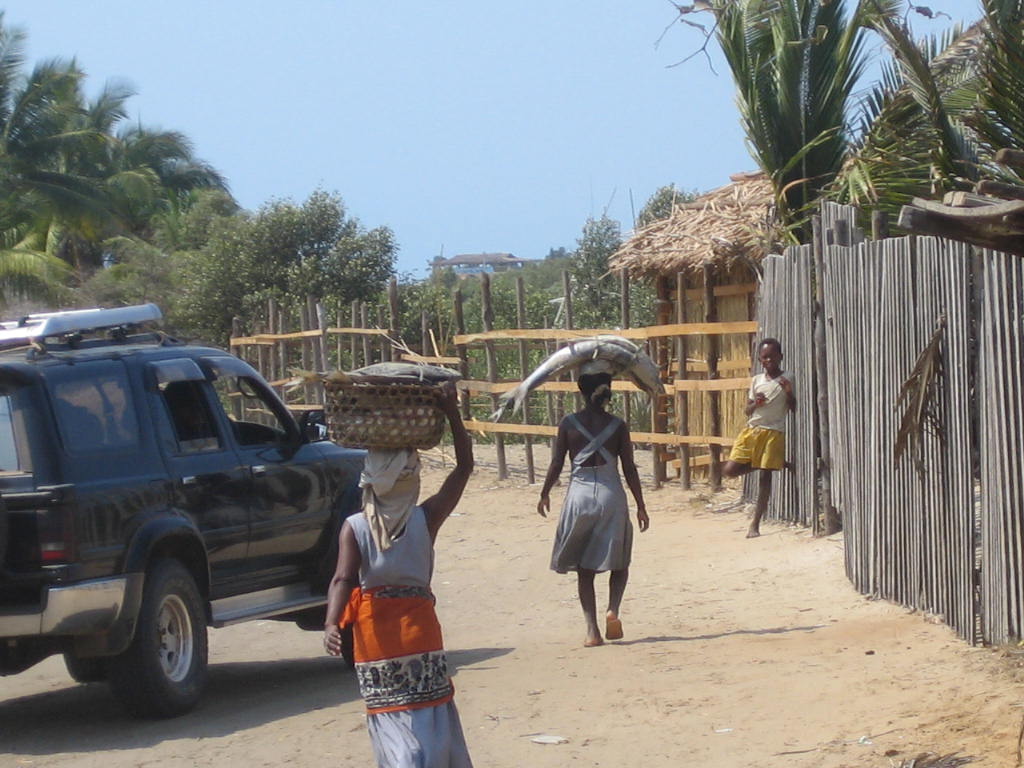
I went to the beach too. It’s not just here on the street—it’s miles long and, unfortunately, wide too. It was quite a long way from the start of the beach to the sea, and then another long way from ankle-deep water to knee-deep water. I didn’t want to walk so far that it was worth getting my swimsuit.
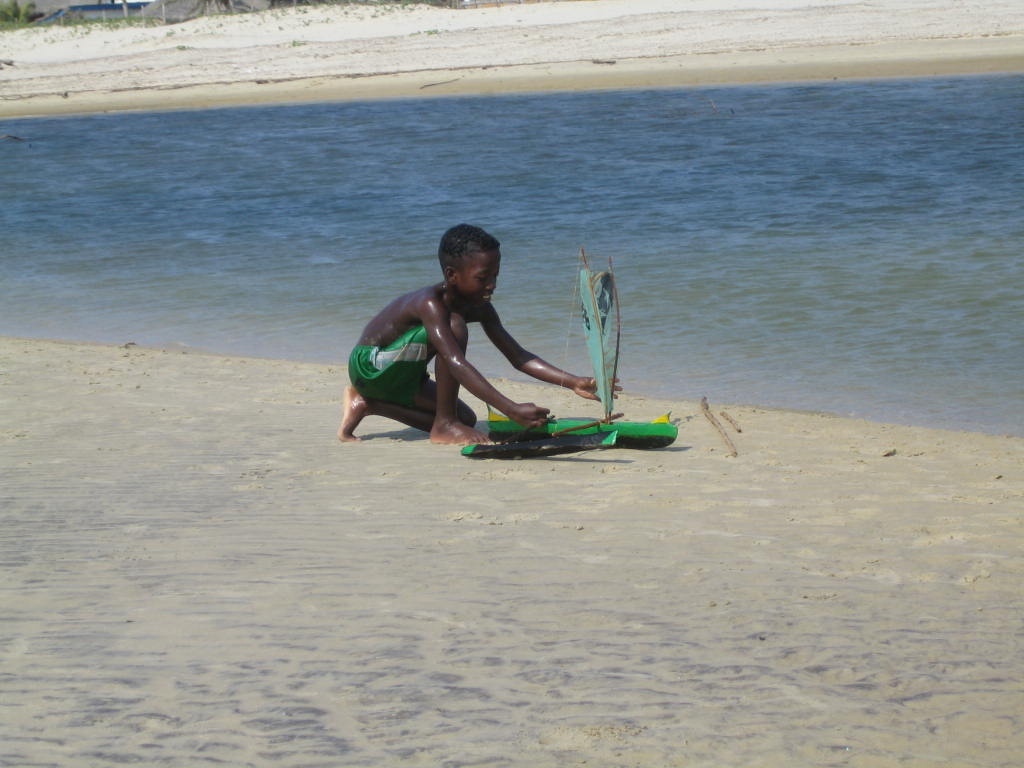
In addition, the wind was quite strong, as the sand on the roads needs to be refilled. This is how the sea reclaims the city. Keeping the sand away would probably require too much effort, which is not in the nature of the Madagascans. And where would you put the sand? So it’s better to let nature take its course.
Kirindy Forest (62.4 km) Saturday, October 7, 2006
Yes, it is possible to cycle into the nature park, but it’s not easy. 47 km through sand with all my luggage would have made it even more of an adventure, but in the “travel light” version – easy-peasy. I was back on the sand before 6 a.m. First through the sand to have a coffee and a few “goodies” at the market. But then I didn’t want to waste any time, I wanted to ride as much as possible in the cool of the morning.
I already knew the first part of the route. But then I turned left. The first time I rode past there, the sight made me feel quite dizzy. But now there was no turning back, so I plunged into the adventure. It was a must to get to the baobab avenue! However, I didn’t find it all that spectacular. It’s probably only spectacular at sunrise or sunset. But even without the alley, they are spectacular here!
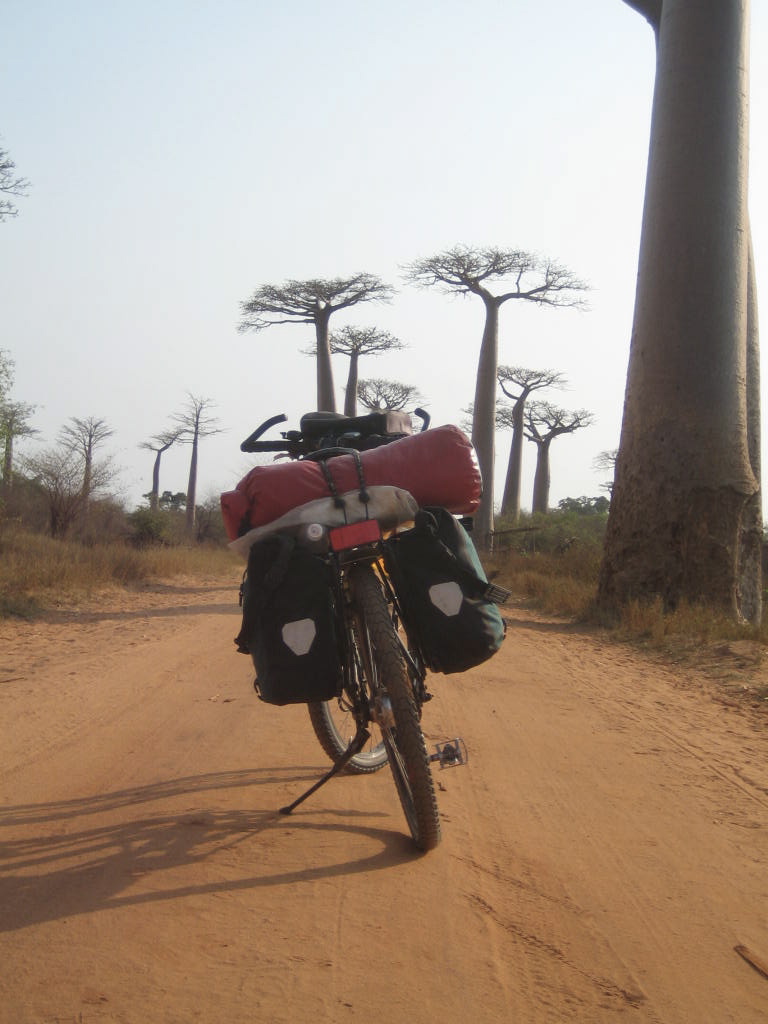
I don’t know what pushed me on, but somehow I just kept riding. It was very interesting: sometimes white sand, sometimes red sand, then brown sand or gray sand—quite colorful, but mainly sand. Here’s a little sandology: White sand is usually very loose and deep. In the worst case, you have to dismount – if you haven’t already done so involuntarily – and look for firmer ground, e.g., red sand. This is usually easy to ride on; if not, you’ll suffer the same fate as with white sand. Brown and gray sand are the lesser evil, especially when wet. It’s especially nice when you’ve just had firmer ground and suddenly a 4×4 comes roaring along. There’s not much you can do but jump into the loose sand. Seeing the taxi brousse, crammed to the brim with bodies and luggage, I was still quite happy with my situation.
In Marofondilia, which is actually quite a large spot on the map but in reality consists almost entirely of a souvenir shop selling carvings by local artists, I was told that it was still about 15 kilometers. You have to give the Madagascans credit for one thing: they are always quite accurate with their distance estimates. “I can do that,” I thought, of course. As before, I continued along the “main road” for about 12 km until I reached the turnoff. And just when you think it can’t get any worse, you are proven wrong. At first, it was just a matter of pushing through deep ruts filled with sand – what else? Every now and then, I was able to ride a few meters. It went on like this for 5 km. Shortly before the end, I thought, “Just don’t fall now,” and then I was on the ground. So I sat there for a while and watched the butterflies. Nothing else was happening. By now it was also quite hot. Fully confident that the route information was correct and that it was less than a kilometer away, I got back up and “continued” / pushed on. And sure enough, I soon saw the welcome sign, even in German. The park is apparently also a stop for the Primate Center of the University of Göttingen.
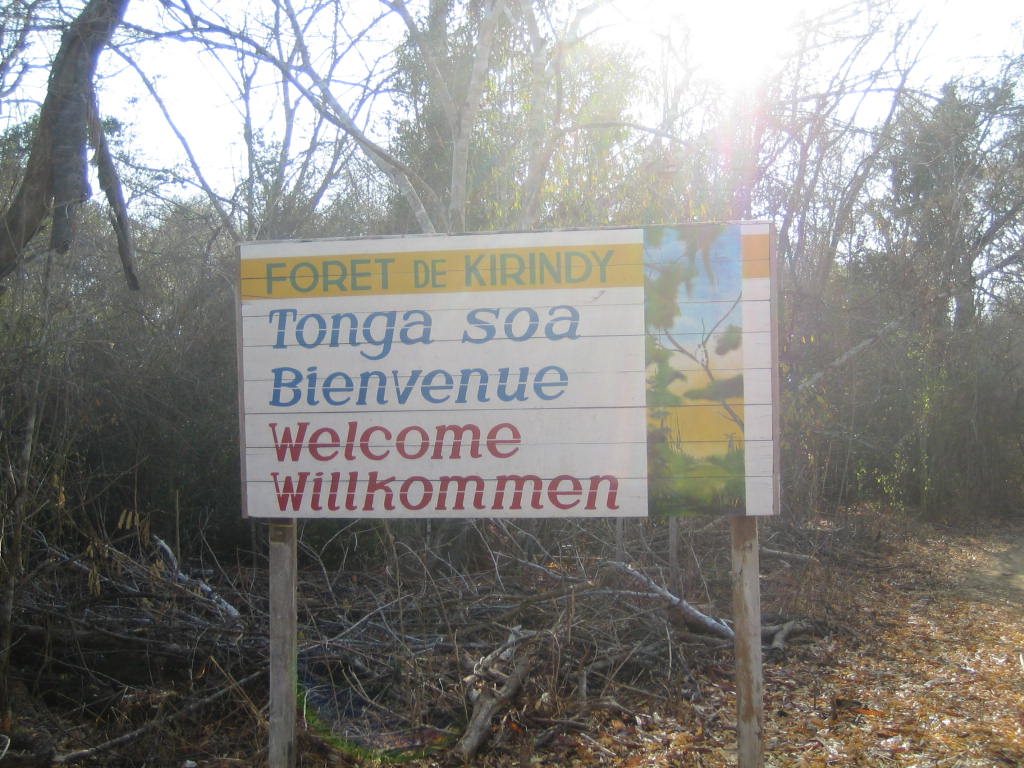
Finally, some shade and a chance to rest. It was lunchtime, so there was no reason to want to see animals. Even they take a siesta in this heat. Unfortunately, I declined the lunch they wanted to serve me. So I had to wait quite a long time before I finally got something to eat.
When I arrived, it was still quite quiet. I arranged with a guide that we would do a day tour from 3 to 5 p.m. How nice, just hanging around, it’s almost like being on vacation. Soon, brown lemurs came to the campsite.

That’s fine, if they come to me, then I don’t have to go to them. Nevertheless, we set off at 3 p.m. The guide wants his money, after all. It was really worth it. I was able to take a few nice photos of at least four different species of lemurs and three species of reptiles, although I hadn’t expected much in the heat and dryness. Back at the camp, I was pretty exhausted and lay down. Food would have to wait.

In the meantime, other tourists had arrived and I had to share my guide with six others. I wouldn’t have minded that if it hadn’t meant the whole tour was extended by an hour. Hungry and tired as I was, I wasn’t happy about that. But I held back because of the other tourists. That’s just how it is when you’re traveling with a group.
At night, we were able to see the night lemur. They are among the smallest lemurs, look like mice, and jump from branch to branch. We also saw the chameleon from noon again; it hadn’t moved much since then. I, in comparison, was hyperactive.

I was happy to finally get my rice and then off to my sleeping bag. At night, I had a visit from a fossa, a kind of fox. Because of this animal, a Japanese tourist, who probably wanted to write a guidebook, had driven one of the guides crazy at lunchtime.
“But why cannot I see one. I need a photo…” – “it’s too hot, they come out at night” – “but where are they now, I cannot wait…”
Neither the Japanese woman’s English nor the guide’s was in any help to understanding.
Morondava 62.4 km Sunday, October 8, 2006
Here I am, lying around and waiting for my luggage. I arrived early in the afternoon, and now it’s already evening. I got my room back right away, but without my things I can’t take a shower, wash my hair, and above all, I can’t change my clothes. And I really need to. Out of pure frustration, I downed a bottle of “Fresh” (shandy). That was too “fresh,” now I’m really freezing. This is another day with many ups and downs.
It rained for the first time tonight, and once again everything between the mat and the tent floor was wet. – That’s how quickly things can change; half the battle is already won. Freshly showered, I’m now sitting at the table. However, I don’t know if it’s right to eat anything. Since the shandy, I’ve had a strange feeling in my stomach. Maybe it’s just hunger. The night will tell. In Kirindy, I came across two rather sick-looking tourists with stomach problems. – So on to the ups and downs of the day.
Packing up the tent right away didn’t work out. But I was able to hang it up during breakfast. It wasn’t so wet anymore when I set off. Lying in the tent at night with the rain pounding down, facing the prospect of the return journey and knowing that I had left my rain jacket in Morondava, it was a strange feeling. But the rain also had its positive sides: Firstly, the sand is firmer and secondly, it’s not nearly as hot. So I set off after breakfast full of confidence. The early morning hours are also usually a good time for animal watching. As it turned out, you can do that from a bike too. A bike safari, so to speak. Two fossas stood in the middle of the path and wondered what I was doing there. (– so I decided to leave the food behind and go straight to bed –)
The return trip seemed less strenuous, and it was also considerably cooler. However, I was quite hungry. At the first stand that finally appeared, I bought a whole bunch of bananas and, to the woman’s amazement, ate almost all of them at once. The junction with the paved road was not far away, where I knew more delicious food was waiting for me. It was still early and I was in no hurry to return to Morondava. I parked my bike at the police checkpoint, which is a common sight in towns here. When I came back, the policeman acted like he was important. As soon as they put on a uniform, they think they’re kings (as I later learned, they are also among the best-paid professions). When I refused to be intimidated, he let me go. The day was basically over, and I was just longing for my deck chair on the veranda of the Tri-Cigogne. That’s where I spent the rest of the day. The rest is history. My stomach has calmed down again.
Toliara 35 km Monday, October 9, 2006
And another lazy day comes to an end. Tomorrow, it’s back to pedaling. At least I got up quite early and pushed my bike through the sand for the last time. Apparently, it rained again in the early hours of the morning. I was at the airport quite early. I was probably the first to check in. The advantage of this is that the ground staff are still quite relaxed. I chose to take a large saddle bag and the handlebar bag as hand luggage so that I wouldn’t go overboard with excess baggage. Since I was flying business class—nothing else was available—I had a 30 kg baggage allowance. The bike and all the other four bags were weighed precisely. I was actually interested to know how much I always carry around with me. But when I asked how much it actually weighed, the employee just winked and said, “30 kg.” Maybe it really is better that I don’t know how many kilos it actually is.
Seeing the west coast from above convinced me that my decision to fly was the right one. You don’t have to cycle everywhere.
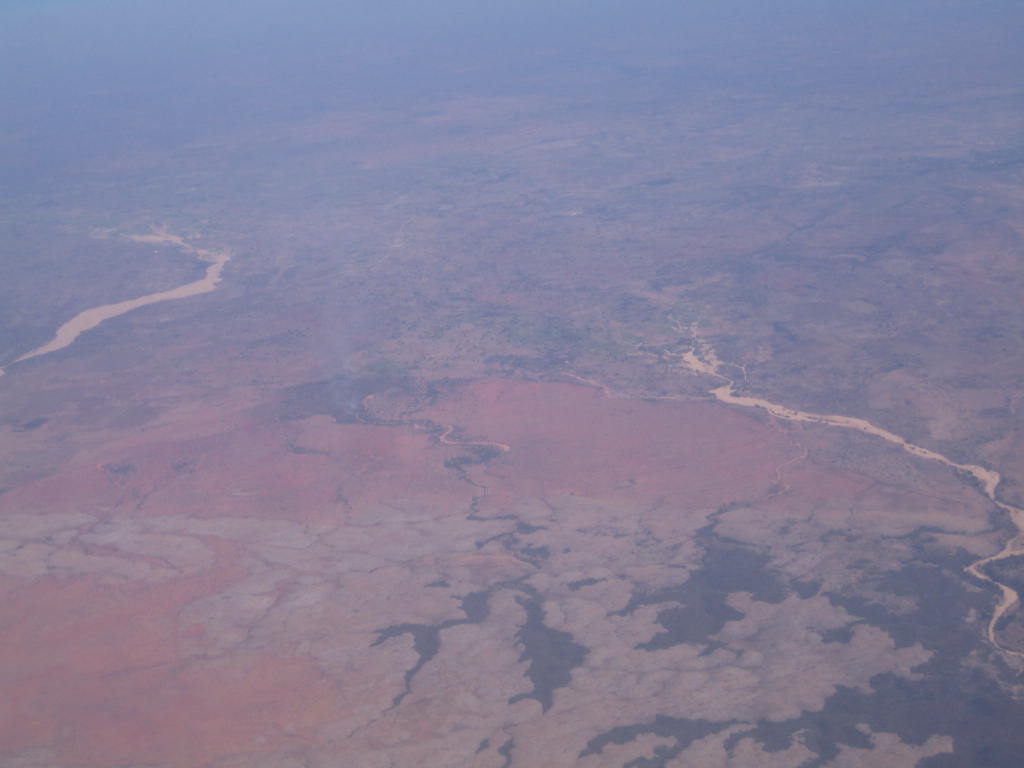
It’s quite deserted and devastated. When crossing the rivers, the problem wouldn’t be the water, but the sand! It’s very frightening when you see it like that. You can tell from the bends that they are actually rivers. The roads are sandy, but they run relatively straight. Only in one river could you see a little moisture. That’s where the only village was. One can only hope that the rainy season will fill the rivers with enough water again. So flying was definitely the better alternative.
In Toliara, I settled right away at “Chez Alain.” It’s in a pretty convenient location. Tomorrow, I’ll be right back on the right road to continue my journey.
This is the first city that is really teeming with German tourists, well organized in tour groups with extra buses. There’s really nothing keeping me here. But I didn’t have the energy to ride out to Ifaty either. So I rode around the city, completely disoriented. I had to be told off by a uniformed officer because I rode the wrong way down a one-way street – really ridiculous. Tomorrow I’ll continue on my way. Overall, I didn’t like the city, but it has a nice big market. There, a little boy swindled me out of a meal. At first I thought you shouldn’t turn down a bowl of rice for a boy, but he ordered the luxury version before I could even react. He also looked like he did this often.
As I drove past the market hall, I heard singing and clapping coming from inside. There was a “troubadour” with a flute, and all the market women and men were singing along and beating time with knives and cleavers.

Finally, I saw the flute and the flutist up close. If I hadn’t had my flute in my room, I would have joined in right away. In the evening, I ate a plate of pasta with vegetables at the restaurant “Chez Alain” so that I could get off to a good start again tomorrow.
Mahaboboka 106 km Tuesday, October 10, 2006
I had headwinds for the entire 100 kilometers, which would have been impressive even in New Zealand. If there’s one thing that’s not worth doing, it’s fighting against the wind. It doesn’t care that I’m cycling towards it. It just blows, and apparently has been doing so for three days. And I was still hoping it would stop around noon. A Madagascan racing cyclist joined me for the first 20 km. “Of course, I’m married and have two children.” He’s still single because he prefers cycling. He also took part in the “Tour de Madagasse.” It was impressive how he pedaled next to me.
When I cursed too much because of the headwind, he just said calmly, “Doucement.” He’s right, actually. Anything else just wastes energy unnecessarily.It took me six hours to cover the first 66 km. The only good thing about it was that it didn’t get too hot. But the headwind really dries you out. Luckily, I had stocked up on water yesterday evening.
There was practically nothing until Andranovory (66 km). But then I really hit my food stops. The place consists almost entirely of food stalls – food as far as the eye can see. And you can eat undisturbed because that’s the village’s sole purpose. This is where the gravel road branches off to the south. All buses and taxi-brousses stop here again. As soon as one arrives, dozens of women grab their bowls and baskets with something to eat, cactus fruits, bananas, or baked goods, and sprint off. They didn’t stir because of me. But I still got my calories.

At some point, I had to tear myself away from all the food. But first, I discovered this place, Mahaboboka, on the map and chose it as my place to stay. I continued on my way feeling much more relaxed. The landscape became more mountainous, but the wind died down and it was simply beautiful. You can already guess what the canyons will be like.
Before reaching this place, children chased me with chameleons. I didn’t find that very funny.
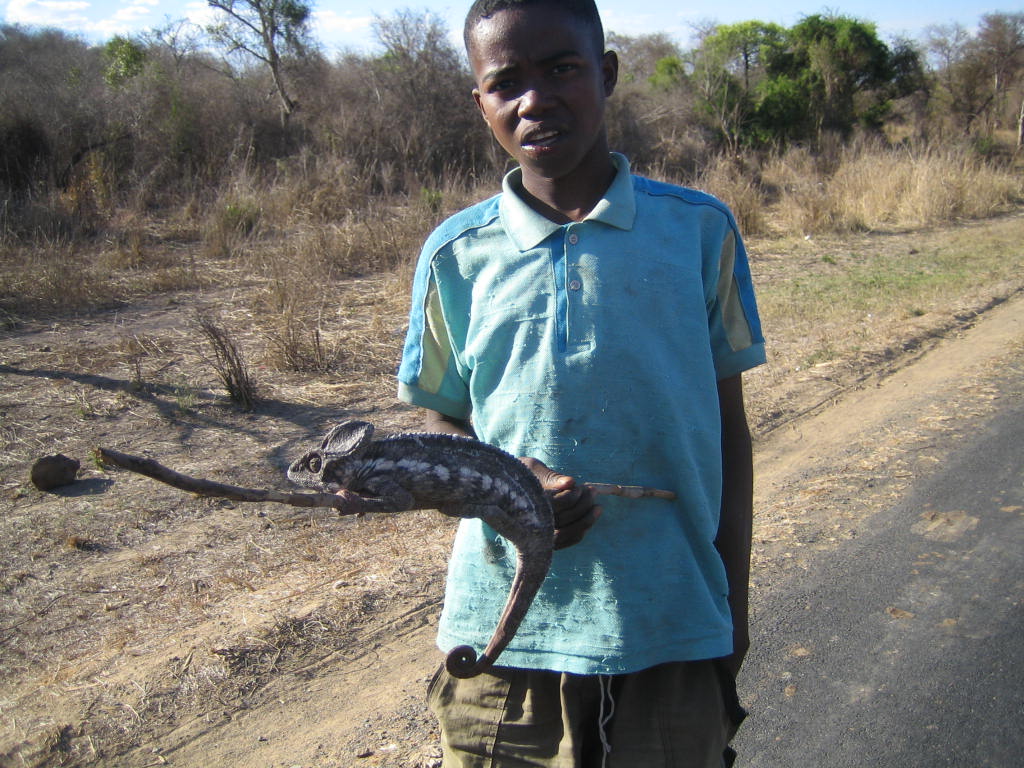
In general, I didn’t find it very inviting for a village where I actually wanted to spend the night. At the beginning of the village, it was still miserably poor. At the other end, I asked a fat “mama” in a hotel for a place to stay, and as usual, I was immediately offered a room.
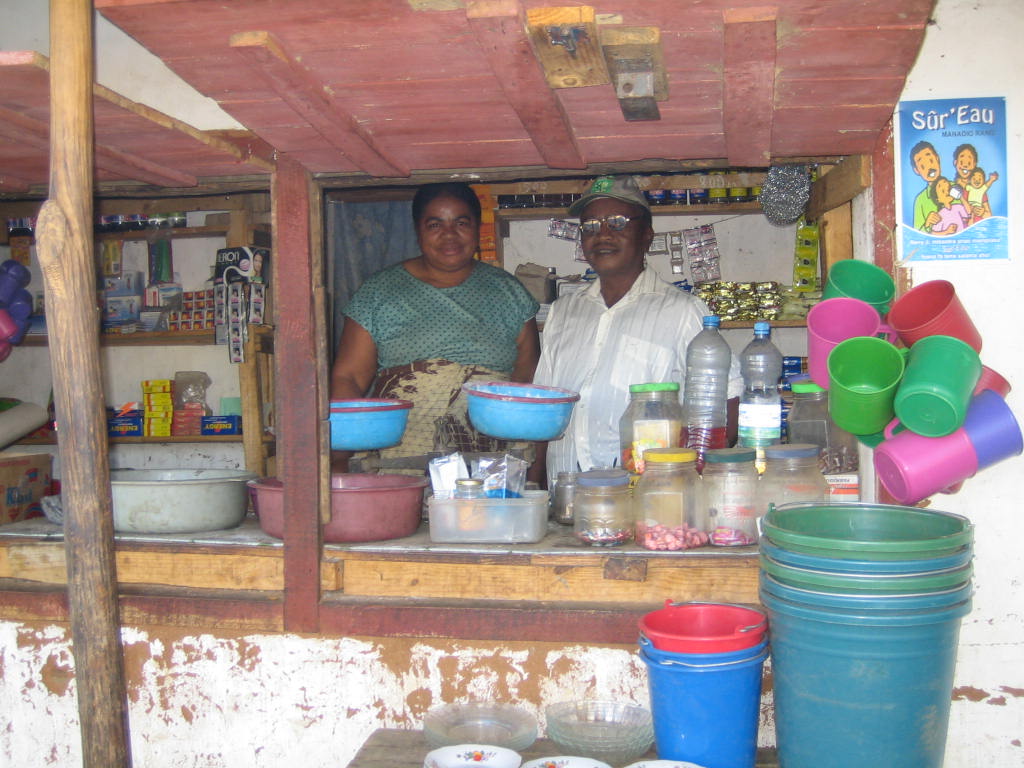
But here, too, I preferred to pitch my tent. So I ended up in the backyard between ducks and charcoal again. Once the tent was set up, I just wanted to go for a short walk. But the daughter of the house led me down to the river, which even had water. A woman was already sitting naked in it, washing herself. I immediately understood what was expected of me.
However, that was not to my liking. All over the country, I have seen men and women sitting naked in rivers, ponds, or whatever else to wash themselves. Nevertheless, I was overcome with embarrassment. And anyway, what do I know about what else is crawling and swimming in the river! So I only went into the water up to my knees with my sandals on and at least washed my arms and legs.
Then the man of the house came home. Fortunately, he spoke French quite well, as he was a teacher. He said he had to – or wanted to – introduce me to the local mayor, who is also the security officer, so that he would know that I was staying here. I had already read about this; this precautionary measure also has its origins in ancient history. The village chief was a very young lad and had no objection to me staying here. Then they cooked for me: huge amounts of rice and a delicious tomato sauce with scrambled eggs. In between, I was always surrounded by at least twenty children who wanted money, candy, or pens. Although this is a fairly fertile area, the children are in a pitiful state; there are simply too many of them. After the meal, the teacher explained the corrupt political situation and the resulting poverty to me. The current president is to blame for everything. The people are starving, have neither water nor electricity, and the president buys himself a plane for election propaganda and pays cash. Elections are in December and everyone hopes that the vice president will return from exile in France. I do not share his opinion that tourism will bring so much good to Madagascar. As is already the case, it is the patrons who will make the big money, and they are Indians or Europeans. All 4×4 drives, hotels, etc. are in white hands. The Madagascans will continue to work for a pittance. Not to mention the fact that sex tourism is also on the rise and tourists consume many times more water than is available.
The woman of the house proudly showed me the shower and toilet. I have nothing against a simple wooden shed, but the floor was swarming with cockroaches! In this case, I prefer nature and am glad to have my tent, where I know my roommates.
Ilakaka 105 km Wednesday, October 11, 2006
When I wanted to pay for my accommodation this morning, they didn’t take anything. They didn’t even want to be paid for the food. On top of that, I got a scarf as a gift. The hospitality of the Madagascans is truly unbeatable. I then took a bottle of water with me and paid a lot for it.
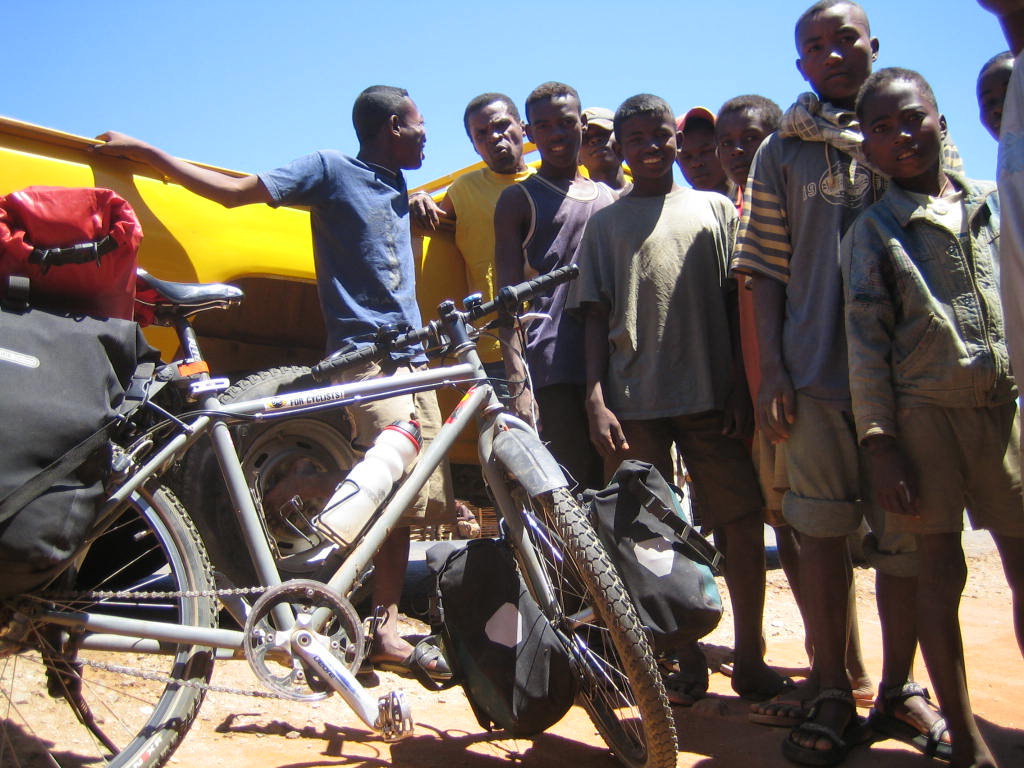
The area between Sarakaka and Ilakaka is a gemstone region. The people here are completely different from those in the rest of Madagascar, mostly of Indian descent. Now I also understand why the road here is so well developed. First, they have money here; second, they certainly have a good lobby with the president; and third, where else would they drive around in their pimped-up cars? But as there are the richest people here, there are also the poorest. This is shown by the dirt, the alcohol, and the resignation. A small town between the gemstone strongholds, Maninday, is one such example.

As a vazaha, it is not pleasant there. However, it is not really dangerous either. The police and military presence, which can be felt everywhere, is far too strong for that. Even from a distance, you can see the remains of plastic bags, and the straw huts are little more than doghouses; people don’t even bother to build proper houses anymore.
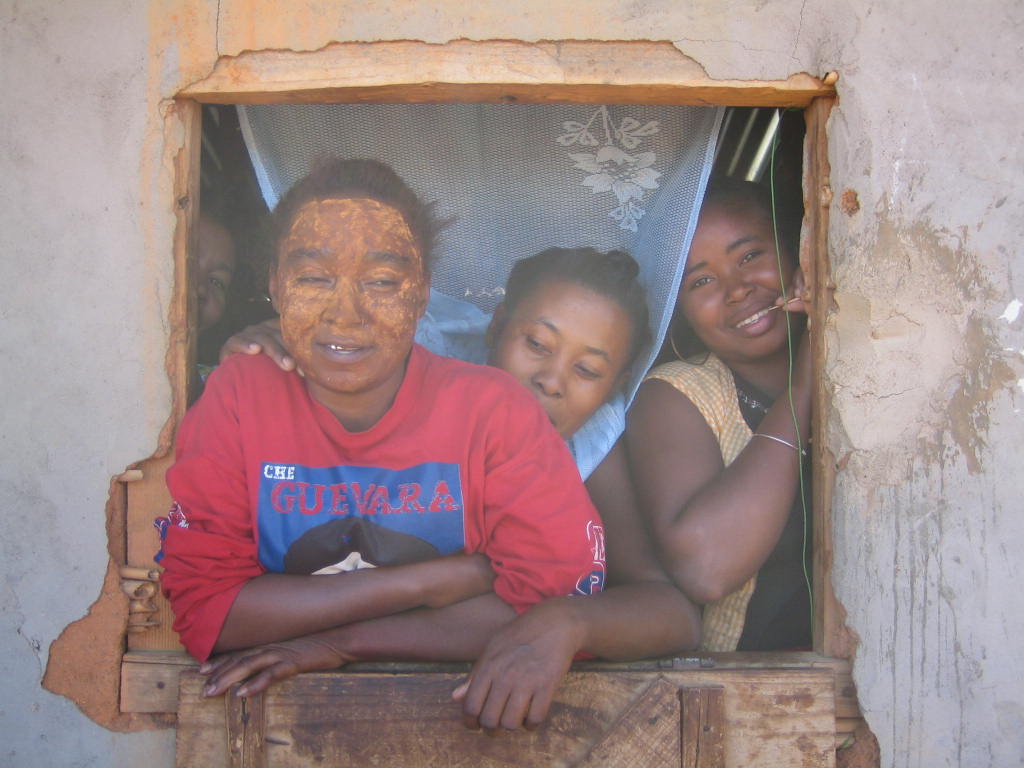
As far as riding my bike is concerned, the day was quite pleasant. The climb up the mountain was quite steep, but not too bad. Part of the route also led through Zombitsy National Park. There I was able to observe lemurs while cycling.
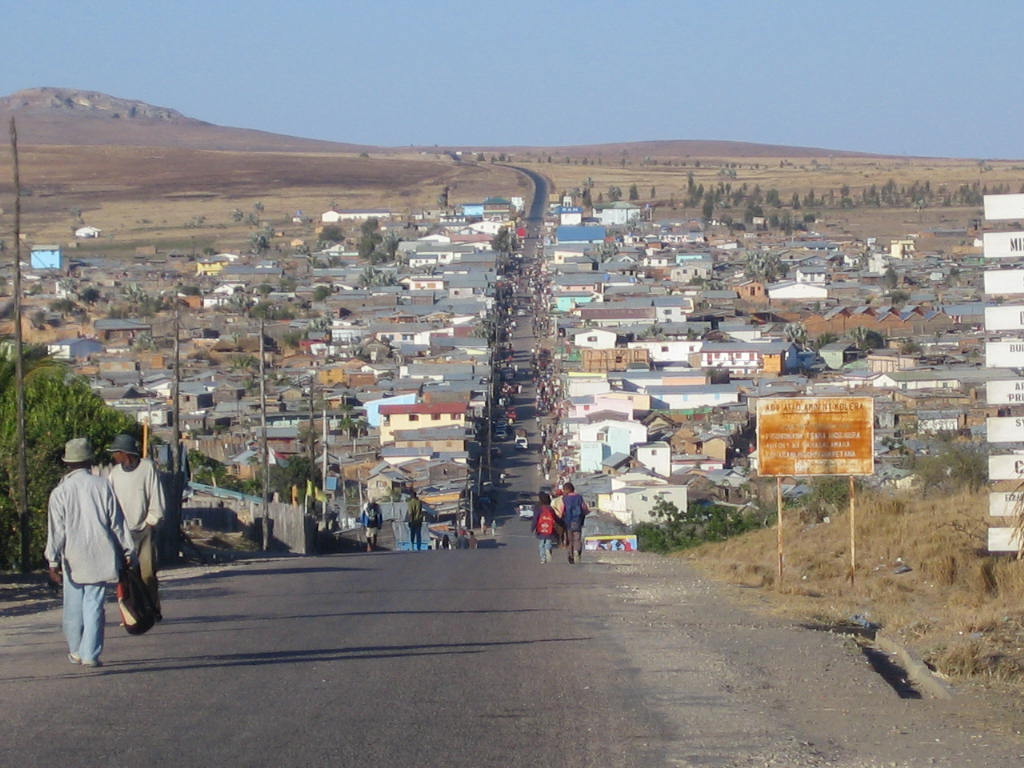
Ilakaka is just a small dot on my map, which normally shows three huts. But since sapphires were found here again, the town has exploded and has an atmosphere like a gold rush town. Everything is all about sapphires. Everyone walks around with a flashlight, which they apparently use to examine the quality of the stones. At the front, right on the street, are the better shops where you can get almost anything, including delicious French pastries such as buns and éclairs, but no honey or peanut butter. Behind them are the straw huts of those who haven’t made it yet, who haven’t found a stone.
Ranohira 57 km Thursday, October 12, 2006
What a beautiful place here on earth. I am sitting by a natural swimming pool, but not in the Parc National de l’Isalo.n hier auf dieser Erde. Ich sitze an einem natürlichen Swimmingpool, aber nicht im Parc National de l’Isalo.

That’s because it’s closed. What is just a shame for me because I can’t see another piece of nature is a disaster for the park guides. A police station along the way already told me that there had been a fire here for two weeks and that all the animals had fled as a result. That’s pretty dramatic. But it was only here that I learned that the entire park – which covers 81,500 hectares – is closed. So no camping at the natural pool. The guides are suffering extreme financial losses as a result. It remains to be seen how long it will take for the animals to return and the plants to grow back.
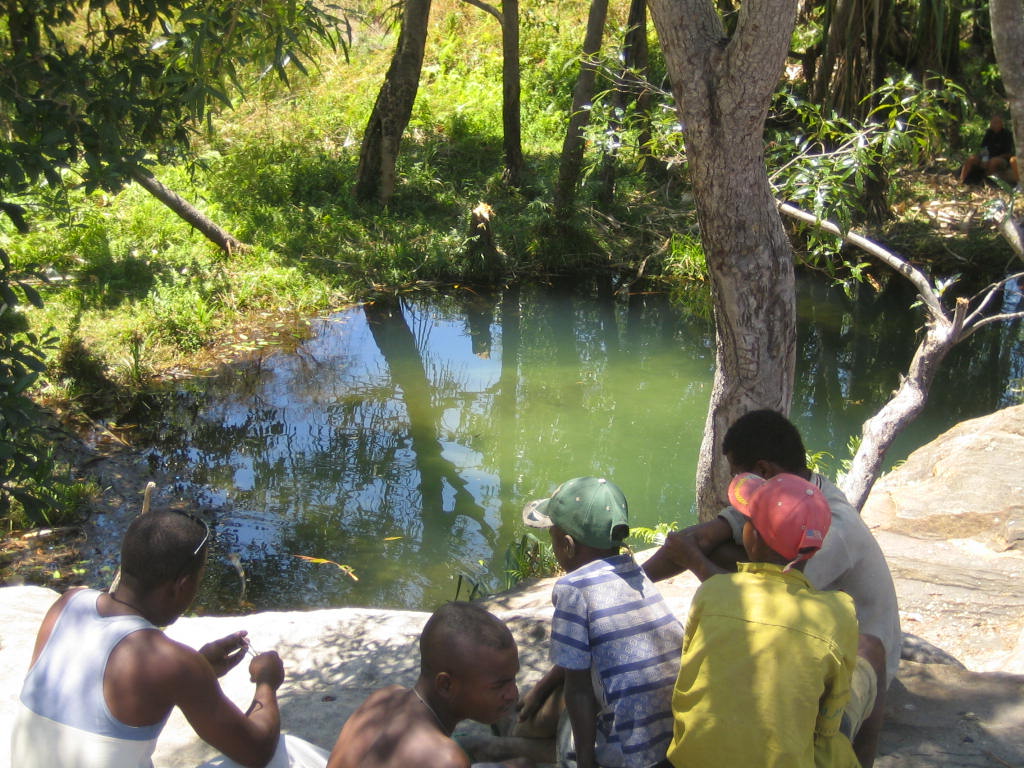
The landscape here is beautiful. The 28 km to Ranohira were a real pleasure, despite the headwind and mountains. I was busy admiring the various rock formations and taking photos the whole time. When I arrived here and found the door locked, I didn’t want to leave right away. I had been dreaming of the natural pool for too long. Then someone recommended an alternative, “l’Oasis de Benny,” where there is also a natural pool and you can camp. I didn’t really want to go there because I had to cycle 15 km back. In the end, I decided to go for it. So far, I don’t regret it. It’s a really pleasant place. I just didn’t want to camp here. I’d rather go back to Ranohira, which is 15 km less tomorrow.

I just saw a magnificent sunset. I’m already lying in my tent and have a wonderful view: the entire mountain range in front of me. Simply magnificent! I’ve cycled the route from “l’Oasis de Benny” to Ranohira three times in total and could do it three more times. Nevertheless, I’m going to move on, even though the park reopens tomorrow. But if I ever come back here, the park will be at the top of my list. Hopefully, it will be green again and full of animals.
Ihosy 90 km Friday, October 13, 2006
I wonder if the constant headwind has something to do with the date? The first 72 km were really awful. It’s a good thing I rode back to Ranohira yesterday, otherwise it would have been even worse. I didn’t sleep particularly well either, practically next to the generator that supplies the whole town with electricity. It was only switched off at dawn, around 4:30 a.m. This source of energy makes earplugs one of the most important travel essentials. The quieter and more secluded the place, the louder it is at night. Let’s see how it goes today. Ihosy is anything but quiet and secluded. There are large colorful brick houses here and the first upscale clothing store I’ve seen in Madagascar.
Today’s route was anything but interesting. Just flat, nothing to slow down the wind. You could watch the cars for hours. I hate seeing three hours in advance where I might be in six hours with a headwind. Actually, the route was quite winding, so I didn’t understand the constant headwind. But with the strength of the wind, it probably doesn’t matter whether it comes directly from the front or slightly from the side.
It’s just sad to know that this was all once forest. Now there is nothing left of it, even less due to clearing by burning, and the wind carries the rest away. No wonder I only passed through one village at the beginning. Hardly anyone can survive here. It reminded me a lot of the Australian outback.
After the intersection with the RN 13 from the south, I cycled around a bend and – the whole splendor of the mountains lay in front of me. Now I saw that I had probably gained quite a bit of altitude. Ihosy lay deep below me. What joy I felt at the end of the day! Now it was 8 km downhill. I managed the remaining 10 km of headwind well. I took a room here for 10,000 ariary, which is 4 euros. The wind is blowing outside, it’s quite cold, and I’m glad I can sit here in the warmth.
Ambalavao 92 km Saturday, October 14, 2006
What a day! You never know what’s coming and where you’ll end up. I’ve probably never started so early before, it was just after 6 a.m. The first adventure was breakfast at the taxi-brousse stand. It’s best not to look at what the others are eating so early in the morning. Luckily, fish doesn’t smell at this time of day. I had my usual bananas in a baguette. Then I set off.
The wind was much more favorable than yesterday. I made very good progress. The first 58 km were a dream. But then I had the ridge behind me and the wind could blow in my face again with full force. Actually, there wasn’t much going on along the entire route. The population density is almost zero. Every now and then you saw a few kraals, but nothing where you could spend the night. Besides, this is a pretty poor area. When I arrived at my planned destination, Arkaramena, it was only 1:30 p.m. and I knew one thing: I wanted to take a break. On the one hand, it was still far too early to set up camp. On the other hand, the headwind had taken away any desire to continue. The next 58 km to Ambalavao look quite mountainous.
Arkaramena is another collection of food stalls, which of course suited me very well. Apparently, others felt the same way, because I met some French people here who work for “Électriciens sans Frontières” (an organization of the French electricity company EDF). As luck would have it, they were also on their way to Ambalavao. But first they had to stop at a “Centre de la Santé” to discuss the installation of solar panels. This was convenient for me in three ways. First, I was interested in their work, second, it was a meaningful way to spend the afternoon, and third, it got me a good distance further. So we loaded the bike onto the car and drove towards Andringitra National Park. It really is a very beautiful area. The “health center” didn’t look particularly trustworthy.
It looked more like a storage room, with almost everything having a UNICEF sticker on it, even an older but completely unused bicycle. After seeing the operating table, I just hoped I would never have an accident here.

There was a long back-and-forth about where to put the battery, how to lay the cables, and whether to pump water from the old well or dig a new one. These things are pretty deep. The old one was 13 meters deep. I wasn’t convinced by the quality of the water either.
At some point, we returned to the RN 7 and drove through fantastic rocky and mountainous landscapes to Ambalavao. Despite all my sporting ambition, I wasn’t unhappy that I wasn’t cycling. The wind was still blowing quite strongly and it was quite a climb up the mountain. In Ambalavao, I stayed at the same hotel as the others. It was a hotel with old French traditions and had its own boulangerie. I started by eating a flan. The room was okay and I had hot water for the first time in two weeks. To celebrate the day, I dined with the others in the restaurant. A Frenchman I had met in Morondava joined us. He talked non-stop. Since everything was in French, I couldn’t really participate. I understand quite a bit, but by the time I figure out how to say something in French, they’ve already moved on to a completely different topic.
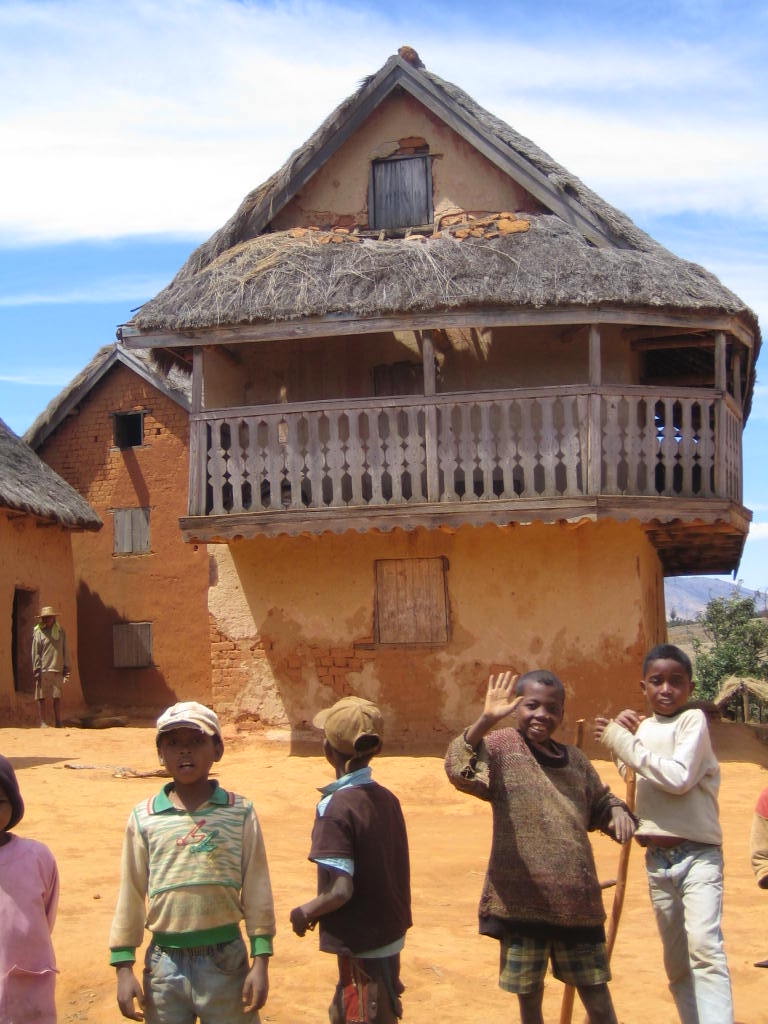
By the way, the city is very interesting and well known for its handicrafts, especially embroidery. The paper with the inlaid plants is also produced here. The hotel was right next to a huge market square where the zebu market is held during the week. Luckily, it was the weekend.
Fianarantsoa 65 km Sunday, October 15, 2006
Since it was only 56 km to get here, I thought I could sleep in a little longer, but that wasn’t going to happen. By the time I finally got to breakfast, my bike was already ready to go. First, I had a really nice breakfast with fresh baguette. Then I set off again through the beautiful countryside. The first 13 km were all uphill, but the rest was okay. It was very varied, though.
At the top of the ridge, I had an encounter of a different kind. A T-shirt from the Löffingen/Black Forest wildlife and leisure park caught my eye, worn by a boy. He didn’t know what was happening. Of course, he didn’t speak a word of French, so he didn’t understand why I had to take a photo of him.
The closer you get to Fianarantsoa, the more populated it becomes. Actually, I didn’t need to eat so much for breakfast. Despite it being Sunday, there was food on offer everywhere. In a village about 17 km before Fianarantsoa, I attended a church service. The church was on top of a hill, and since not everyone could fit inside, lots of people sat outside on the lawn, where loudspeakers had been set up. I had wanted to attend a church service for a long time, but since I always attract a lot of attention, I didn’t want to steal the show from the pastor. He didn’t notice anything, though. As soon as I sat down with the others, about 50 children gathered around me again, forming a semicircle at a safe distance. They can stare at you with such intensity, it’s unbelievable. The entire service consisted of singing. A young woman sat down next to me and let me look at her hymn book. So I was able to sing along, much to the amusement of the others.
I arrived in Fianarantsoa quite early again. I don’t like the hotel I chose, and it’s also quite expensive for the price. I actually wanted to camp in the garden, but apparently that’s only allowed if there are no rooms available. So I ended up taking a room for 16,000 ariary.
Madagascan “big cities” are bad enough as it is, but on Sundays they are a complete disaster. So utterly lifeless, everything gray and closed. The whole city consists of a main hill, “Rova,” where the crazy queen had her secondary palace built, and various secondary hills. So as far as the location is concerned, I’m quite happy with the hotel. It’s not far from the main road. Once again, I cycled through the city just for sightseeing. Where I couldn’t ride any further, I carried my bike up a few steps. Up there, it suddenly became quite touristy, with lots of children following me and trying to sell me something. Tomorrow I have to go to the Mad Air office and stock up at the supermarket.
Ranomafana 61 km Monday, October 16, 2006
What a brilliant day once again. Because of my shopping, I didn’t set off until quite late. But the time was well spent, because now I know that there are no flights to Tana. So I have to change my (already vague) plans again. Someone wise once said, “Planning is everything, the plan itself counts for nothing.” Oh, how true. Besides, I couldn’t find any peanut butter in the supermarket. I think I’ll really have to get used to bananas as a spread.
The first 10 km out of Fiana were a nightmare. Bricks were being fired everywhere. The traffic was terrible, especially compared to what I was used to. After turning off the RN 7, it was a dream again. When I set off, I realized that I had lost the screw from my cycling shoe for the third time. That didn’t improve my mood either. You can’t find suitable screws here in Madagascar, you have to saw them to size. I still had one screw in my pocket, and as busy as the arterial road looked, I thought I would be able to find someone to help me. And sure enough, there was a craftsman at work, and in no time at all, the screw was cut to size. Of course, he did it the Madagascan way: for free. It was an honor for him. I gave him some money anyway, and gave his son my cookies.
I almost missed the turn-off to Ranomafana if I hadn’t happened to ask the road workers. The road to the east coast was supposed to have been repaved, but it looks like some repairs are already needed. There were many construction sites along the way, especially on bridges, and almost the entire route was gravel. Not a pleasure to cycle on, but I’m used to worse. Since it was almost all uphill, the road surface wasn’t such a big problem. Shortly before the national park, there was another cluster of food stalls. There I met a French couple who talked enthusiastically about hot springs and massages in Ranomafana. Something else to look forward to.
The campground that belongs to the national park is a dream. I think this is the first campground I’ve ever seen that has covered camping spots.
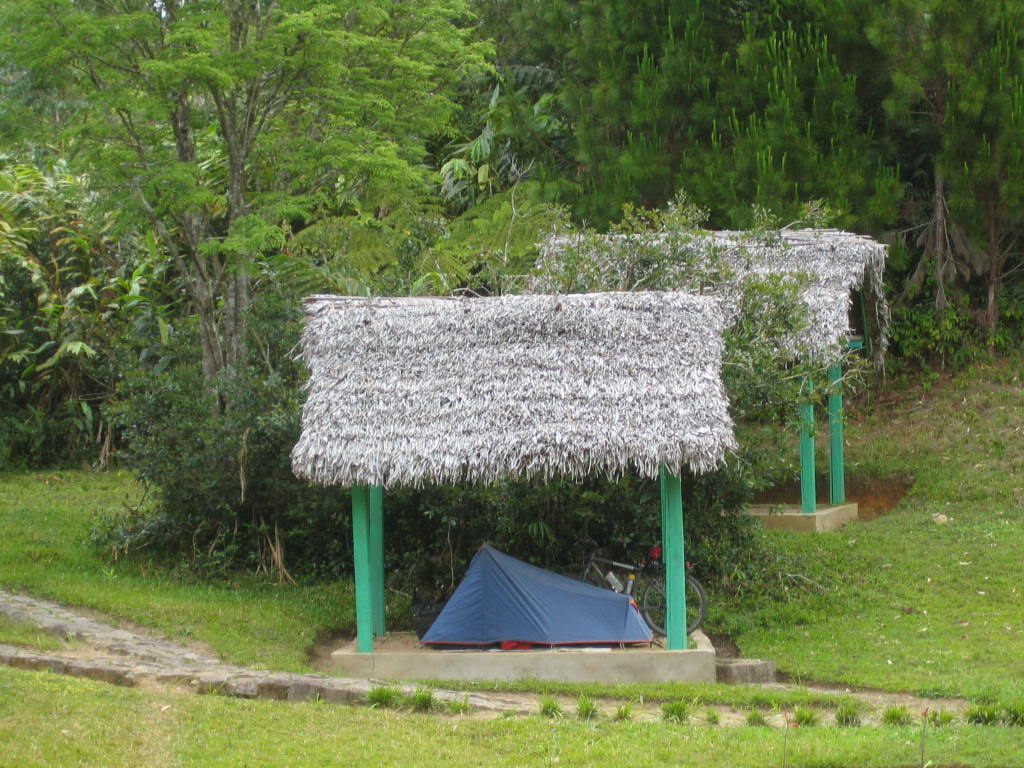
This is probably also appropriate in the rainforest. It’s completely different here than in the West. Endless water, streams, waterfalls, and therefore ferns, orchids, and palm trees. Fog, drizzle. The sanitary facilities are not yet up to European standards, but they are far better than what you usually find in Madagascar. There was a guide waiting at the entrance to the national park. I got persuaded to go on a two-hour night tour, which turned out to be quite a rip-off. Admission to the park costs 25,000 ariary, and another 20,000 for two hours. That’s less than 20 euros, but almost a month’s salary for a normal Madagascan. What you got in return was far behind what Kirindy had to offer. Everything is beautifully laid out for tourists and it is a beautiful rainforest, but in the end you are led to a night spot where there are three types of animals: fanaloka (a type of fossa), mongooses, and the smallest lemurs. Bait is laid out for them so that they always appear in time for the tourists. They are already used to the hustle and bustle, and not even the flurry of camera flashes could disturb them anymore. You are by no means the only tourist; at least 20 others are already there. The whole thing took less than two hours. So now I have another experience under my belt. Back at the campsite, I saw that my tent had company. A whole herd of German biology students, some of whom I had already seen at Parc d’Isalo, had arrived. It was quite a nice evening’s entertainment.
Ranomafana 23 km Tuesday, October 17, 2006
What a day! A vacation day like this is more suited to a woman my age. I actually got up quite early this morning, which could be classified as senile bed escape or, rather, sleeping bag escape. I just wonder how long the young people can stand it in their tents. Then there was German Nescafé again, which tasted delicious after the terrible drink the day before. After the sun had dispelled the fog, I went down to the village. A wonderful descent: 7 km along the river with waterfalls and ferns everywhere, just as you would imagine Madagascar to be, a real rainforest.

And because it was so beautiful, I went a little further. It’s a shame that I can’t fly from the coast to Tana. At some point, I turned back again; this was supposed to be a day of rest. Of course, I didn’t go to the bathroom until I had eaten something: two yogurts and bananas.
The baths were certainly quite posh during colonial times, but now they are a bit run down, though clean. First, I had to sit in a tub of hot water for fifteen minutes, which I could hardly stand. Then I had a massage, which was certainly longer than 30 minutes – simply brilliant. I noticed that my calves had been affected a bit. The massage also did my shoulder a lot of good. Before going to the swimming pool, I needed a break first. So I went back to the village to have something to drink and eat. I also found some postcards. But otherwise, there’s nothing going on. There are hardly any tourists at the bathing establishment either. Those who do come just take a quick look and then move on. When I arrived at the swimming pool, there was only one Madagascan woman there. An older Dutch couple was just leaving. Fortunately, the water was much too warm to swim properly, otherwise I would certainly have been annoyed that I had forgotten my swimming cap and goggles. So I just paddled back and forth a little in the warm water.
As long as I was there, there were almost only Madagascans. It was really nice and relaxing. The ride up the mountain to the campsite was also quite pleasant. How different everything looks in this direction. I completely overlooked some things on the way down. The German students weren’t so enthusiastic about their day; apparently, the park is full of tourists during the day. Luckily, I was spared that.
Ambositra 130 km Wednesday, October 18, 2006
I simply can’t handle more than two cars per hour. This is like a highway! Nevertheless, I endured it for so long. It was almost always uphill. If the last 20 km hadn’t been somewhat downhill, I wouldn’t have made it. And everything started out quite exhausting today. First, I had to carry all my luggage and my bike up from the campsite, then cycle 6.6 km up to the turn-off, but it was beautiful. So early in the morning, the birds were chirping and there were hardly any cars on the road. Then the turn-off onto the gravel road. It was much easier to ride on than I had first thought, but quite uphill and downhill, yet still beautiful through the rainforest. Then back onto the RN7. At times it was okay, but as I said, more than two cars are unbearable. I don’t know what they drive here, but there’s always black smoke coming out of the exhaust, if it’s still running at all. Many just stay on the road, end up in the ditch or simply tip over. I am convinced that I am much better off on my bike. Besides, you also contribute to the amusement of the population. Today, when I was pedaling up one of the hundred hills fully loaded, an old woman stood at the side of the road laughing and shaking her head. The only thing she said was “Ojiijojojoj.”
I met two German cyclists today. Of course, they were riding in the “mollycoddle” direction. I don’t think any other cyclists are tackling the route in this direction except me. When I arrived here in Ambositra (pronounced Ambuschtr), I first had to find something to eat, and then suddenly it was dark. So I had no choice but to take refuge in the nearest hotel. Now I’m waiting for my food and then I’m looking forward to my bed. That was pretty tough today.
Antananarivo 8 km Thursday, October 19, 2006
Only cycled 8 km and yet about 280 km further. If you haven’t taken a taxi-brousse in Madagascar, you haven’t really been to Madagascar. Well, I just didn’t feel like cycling the last stretch on the RN7 back to the capital. There are certainly more beautiful routes on the east coast. So after breakfast, I made my way to the taxi-brousse stand. Before I even got there, one was already waiting. In no time at all, all my luggage, including my bike, was stowed on the roof. While I was still buying cookies for the rather long journey, the car suddenly disappeared, but I was assured that it would come back. I trusted them completely. Sure enough, it did come back, and at around 7 a.m. sharp, we set off, unfortunately not to Tana, but only to the official taxi-brousse stand for the time being.
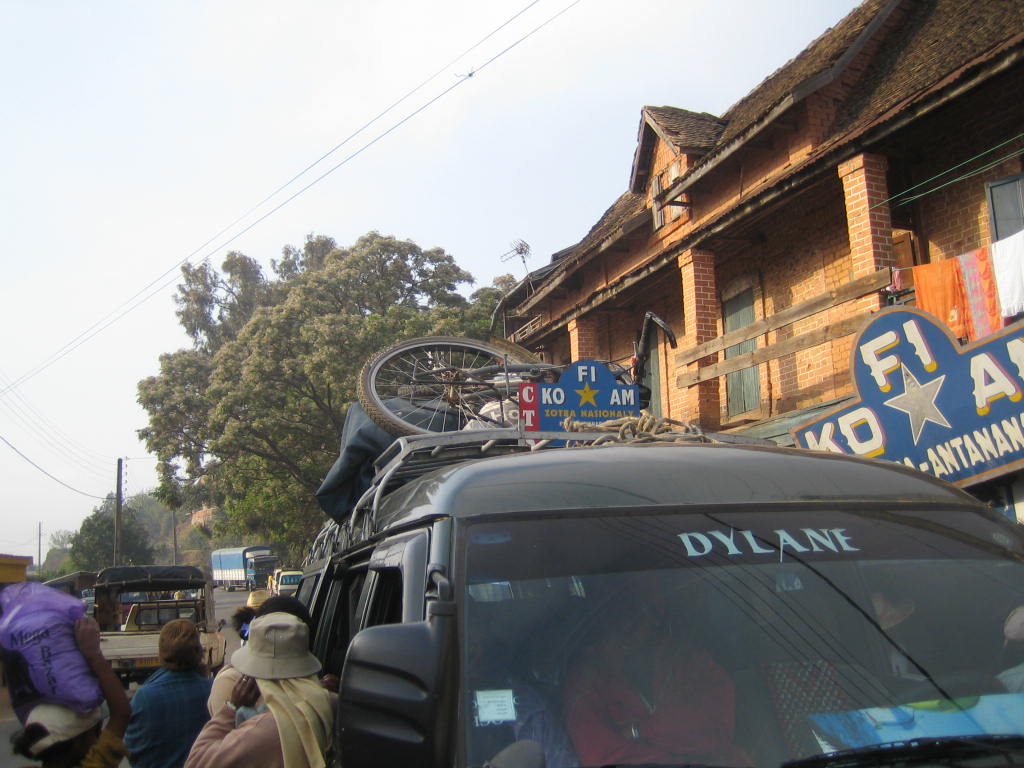
There, we waited until the last seat was taken. No taxi leaves before that, even if the wait takes hours. For us, it was 45 minutes, and no one minded. The journey itself was not that spectacular. Probably because it was a “long distance” taxi-brousse. Everyone sitting in it was going to Tana, and since every seat was already taken, there was no reason to stop. Once, it did stop to load sacks full of branches and leaves, which were then unloaded again in Antsirabe. After a short break, which I spent squeezed into my window seat, we continued on our way, winding our way across the highlands. I struggled to keep my breakfast down. The bicycle is definitely the better alternative.
From this perspective, I saw that cyclists also live dangerously. Drivers don’t like to brake for these two-wheeled road users, only reluctantly when something is coming towards them and they can no longer overtake. It can get pretty close.
I don’t know why so many taxis flip over or break down. They are checked thoroughly at every police station. That’s why I was sure that the bike and the other luggage would remain intact. Nevertheless, I saw another spectacular accident today. A truck veered off the road and took half of a mud house with it. In return, it left half of the cab there. In Germany, the radio and television would have been there long ago, but here you get the feeling that it’s part of everyday life.
The taxi stopped a third time – for “recreation,” as the woman sitting next to me said. It looked like this: the men disappeared into the bushes on one side of the road, the women on the other. What do you need public toilets for here? I don’t know how they solve the problem of toilet paper, or rather the lack of it. I don’t want to look too closely.
I was glad when we arrived in the capital exactly five hours later and I still had all my food inside me.
On the road, I suddenly had to deal with heavy traffic again, which I am absolutely not used to anymore. Since I didn’t want to stay at the Sakamanga Hotel this time, I chose another hotel. That meant first going through the city center and looking for a place to stay. At the first one, you could see right away that it couldn’t be bike-friendly. It could only be reached via a long, steep staircase. Tana is very mountainous, so that kind of thing happens. So I moved on to the second alternative. I had better luck with the Moonlight Hotel. I could push my bike almost all the way to my room, and it’s clean and inexpensive.
Since I had a few things to do here, I had to leave right away: first to get money, then to pay for my upcoming flight and, most importantly, to go to the supermarket. I walked there, which was quite exhausting. You’re much more at the mercy of beggars. On every street corner, you’re offered vanilla or other junk that you don’t need. In addition, children are always scurrying between your legs. It’s quite nerve-wracking. A “normal” woman approached me. She started telling me about an aid organization, but I declined, quite annoyed, which I later regretted. Actually, I would have been interested.
I often don’t know how to behave properly here. Every now and then I give something away, even though I know it doesn’t help them much. That makes them even more unbearable. Maybe you shouldn’t give anything to the children, but only to an aid organization that gives the children a home and food. Why are there so many children here? “Ny olona no harena” (“People are the true wealth,” Madagascan proverb)
Moramanga, 112 km, Friday, October 20, 2006
Overall, it was a pretty nice day, with ups and downs, or rather downs and ups, because the bad stuff came first. It took me an hour to get the 7 km out of Tana. It was just awful. The city consists almost entirely of cobblestones, hills, and one-way streets. Street names are also difficult to recognize. At some point, I was at least heading in the right direction. A Madagascan cyclist then guided me onto the RN2 via back roads. However, the traffic was still pretty awful for the first 20 km. Then it was uphill all the way. Because I wasn’t expecting it at all, it was really getting on my nerves. Then it went downhill again and was fairly flat for a while. When it went uphill again, long and steep, I found it more bearable. Shortly before the summit, I met the two motorcyclists from the beginning of my trip. They came from the east coast and were fleeing the rain there. Apparently, it rains constantly on Île Sainte Marie. That reminds me, in Australia and New Zealand, the weather forecast was very important to me. But here, I didn’t really care until now, because the weather was always nice anyway. Well, I’m curious to see how my last 10 days will turn out. Hopefully, my vacation won’t be a washout. I actually wanted to spend another day or two at the beach.
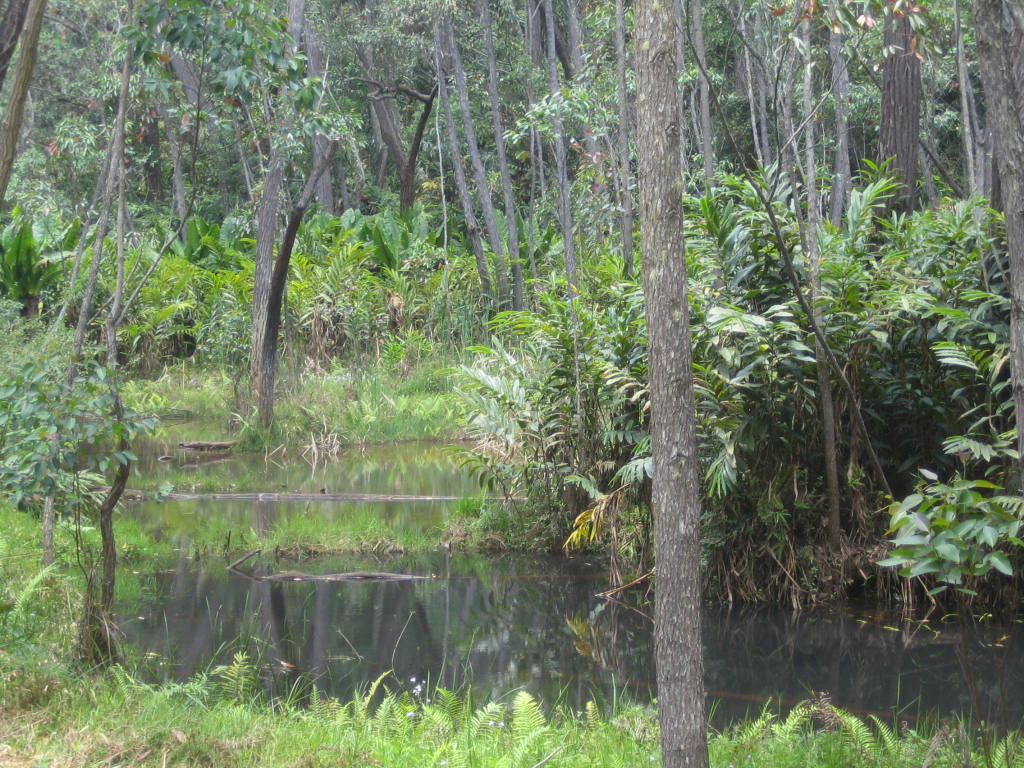
After the summit came one of the most spectacular descents, right down into a gorge. It’s just nice when a little stream babbles alongside you, especially when it’s flowing in the right direction. Not even the numerous tanker trucks bother you.

The road largely follows the railway line. I don’t understand why they didn’t keep it in operation. All the containers from the port in Tamatave to Tana would be better off on the rails. But it looks as if the line is being put back into service, at least work is underway. The environment would be grateful; it’s unthinkable what would happen if a tanker like that were to tip over and leak.
In the end, it became mountainous again, which is why I wasn’t here early enough to consider continuing my journey. This is a larger city, so it’s no problem to find a hotel. The accommodation wouldn’t be too bad if there was water and the music would finally stop. The whole city seems to have a water problem. Apparently, there will be water from the tap tomorrow morning from 6 a.m. Instead, I have something that Lonely Planet calls a “bucket shower.” Two large buckets of not-so-clean water and a mug so you can pour the water over yourself. The water quality is sufficient for washing, for everything else there is bottled water.
Today, I heard a shepherd playing the flute for the first time again. Apparently, they only exist in the central highlands. It sounds very beautiful, especially with the echo in the mountains.
Andasibe National Park, 46 km, Saturday, October 21, 2006
It’s so nice and quiet here. After the terrible last night, it’s a real treat. At 8 p.m., the music stopped briefly, but only to start again at full volume at 9 p.m. I felt like I was lying in the middle of a club.
They don’t have water, but they have endless electricity for the amplifiers. Once again, thanks to earplugs, I was able to sleep for a few hours. It wasn’t until 4:30 a.m. this morning that it got a little quieter. But as usual, I got up shortly after 5 a.m., made coffee in the shower, and set off early. It wasn’t a long distance to cover.
Somehow, I was in a really good mood and even felt well-rested. The route was mountainous, but once again beautiful. I arrived here quite early and asked whether it would be better to see the indris, lemurs, right away or in the late afternoon. They said late afternoon.
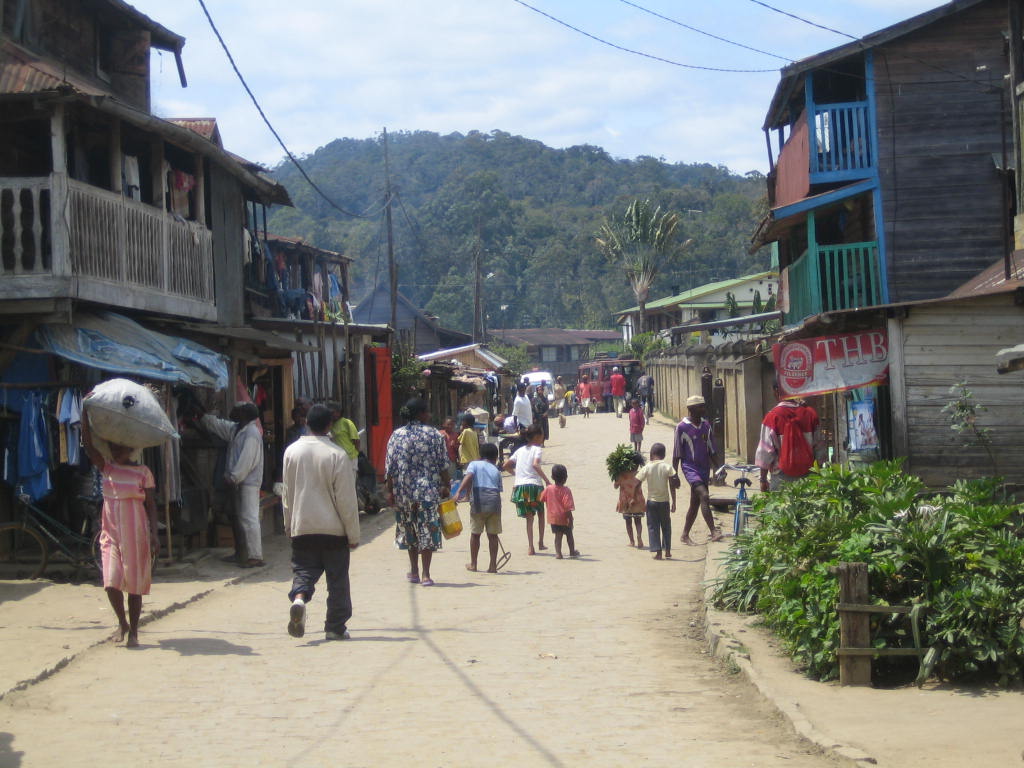
So I set off for Andasibe and continued through the forest to one of the most luxurious hotels in Madagascar, the Forest Lodge. The route through the forest was beautiful and the road was surprisingly good. It wasn’t paved, of course, but it was still easy to drive on. After cycling through the jungle, you come to a gate and then you’re in another world: manicured lawns (golf course), colorful bushes and flowers. Directly above the lake is a large round building, the main building of the lodge. It’s beautiful, but totally unrealistic. That’s why I turned around right away.

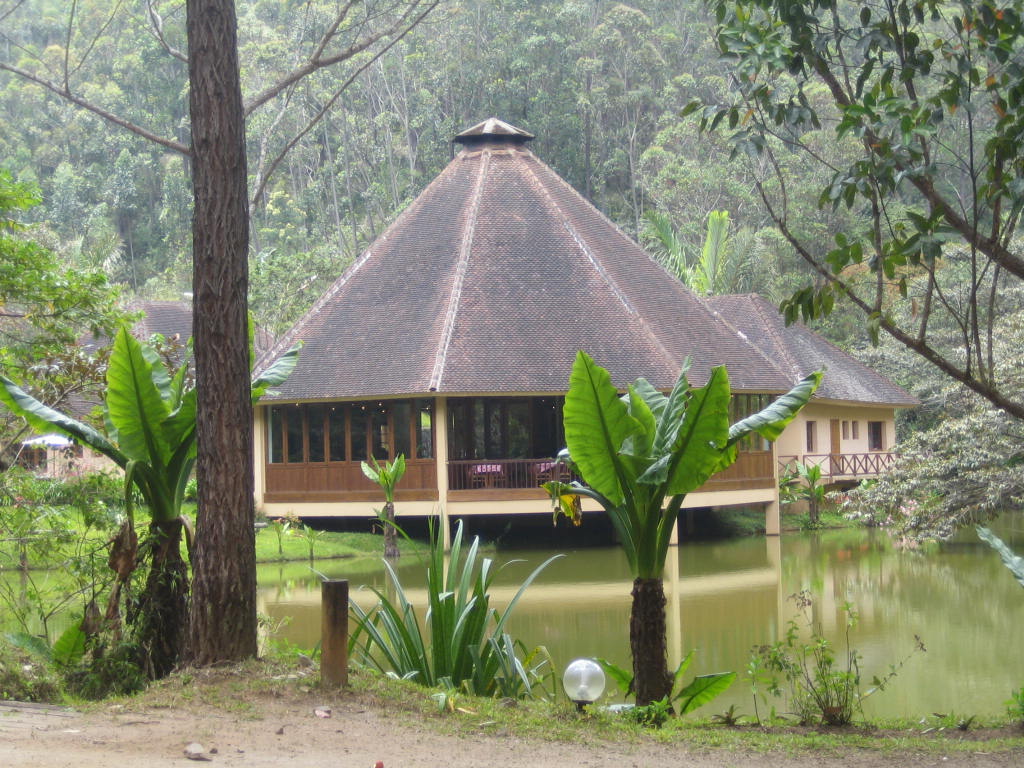
I waited at the park, enjoyed the peace and quiet, and met a couple I’ve run into quite a few times before. Another conversation in German. When it was time to go on a tour, I was told that I could forget about it, as the indris would no longer be visible today. I should have gone first thing this morning. Great. So I checked that off my list too. Maybe I’ll see them tomorrow morning from my campsite. But I’m not staying here another day and night. I don’t feel quite right here. Right now, it looks like a thunderstorm is coming.
Since the tour was a no-go, I decided to take a long shower. But when I was standing there naked, the water stopped running. I didn’t check it until the next morning. Somehow, I found it funny. Welcome to Africa! So I got dressed and went back to the park reception to complain again. I’m such a nasty German tourist! I’ve already complained that the lights aren’t working. When will I finally learn that I’m here in Africa and should be happy if anything works at all? After checking the water pipes, I was told that work was in progress and the water should be back in an hour. And sure enough, it was splashing again later on. But my desire to take a shower hadn’t been washed away, it had somehow disappeared. It’s about to get dark and, as I said, the lights aren’t working. In the meantime, I did what I could always do: eat. It even involved cooking. So, now it’s getting completely dark, let’s see what the weather does.
Brickaville, 116 km, Sunday, October 22, 2006
What a great day for cycling! The first 30 km were simply a dream, compensating me for not seeing any indris after all. It was probably too early. The night wasn’t so pleasant, even though the thunderstorm didn’t come. Instead, the guides celebrated, as it was Saturday. There’s nothing else around for miles, just the campground and the tour guides’ house across the street. I got up quite early this morning because I wanted to make it here, which was no problem. As I said, but it can’t be said often enough, the first 30 km were simply a dream: wonderful scenery and mostly downhill.
Once again, I was the only one on the road so early in the morning. It was also good that I rode the route on a Sunday. There were tanker trucks and containers on the road or in the ditch, but not nearly as many as on the previous days. The landscape was actually always wonderful, with many different palm trees and beautiful bushes, but later on it became quite hilly. You could also tell from the heat that I had lost quite a bit of altitude. But the wind helped to cool things down. After the turn-off towards Tamatave, it was like a yo-yo: 100 m up, 100 m down, then up again, then down again. This part of Madagascar is completely different from the rest of the island.
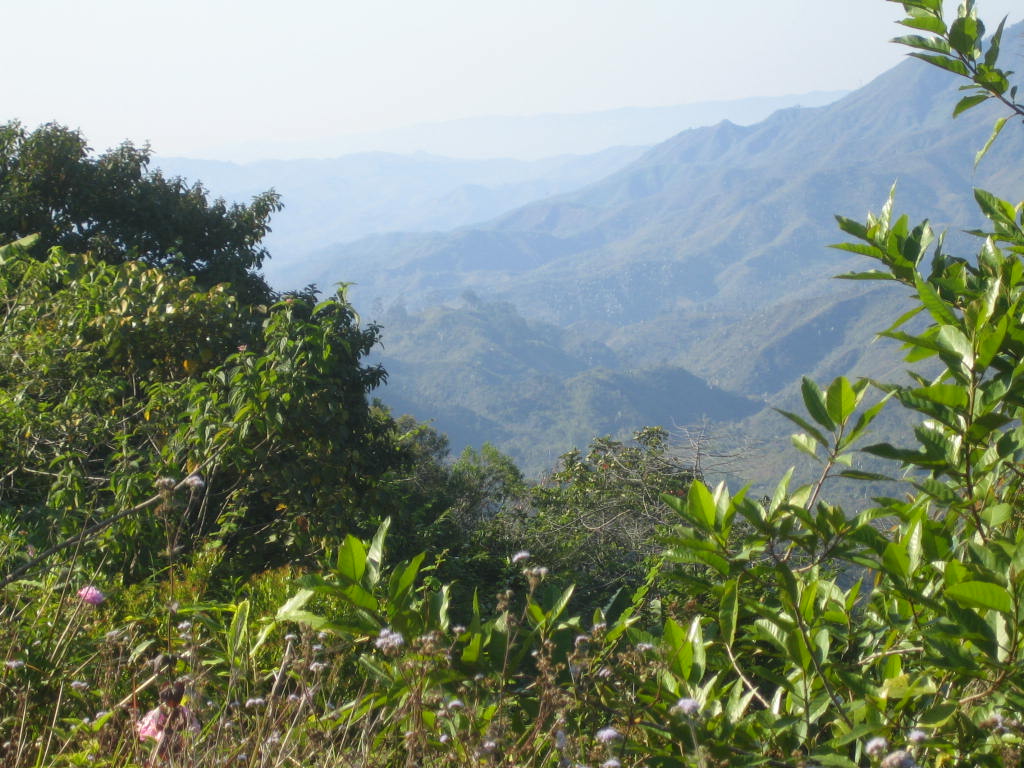
Not only is the landscape more diverse, but so is the population. There are also very poor people here, but on the other hand, there are still quite a few white people living here. Except in Morondava and Tulear, I haven’t seen any white drivers. There are a few here. Mostly in VW Passats, which you don’t usually see. Near Tana, on the other hand, there was a lot of advertising for Audi and VW. This has an extremely positive effect on me, as no one gives a damn about me. Finally, I can sit down in peace, rest, eat something without feeling guilty, because here there are also really fat Madagascans, like nowhere else.
Toamasina (Tamatave), 111 km, Monday, October 23, 2006
Judging by the price, this should be a luxury hotel, but it’s not exactly that. They probably doubled the price here and put a TV in every room, which you absolutely need, since my travel guide described it as a “very good value choice.” When I arrived here, I was exhausted and didn’t want to continue with all my luggage. In the end, I thought, it’s only for one night. So I took another long, hot shower.
The city itself is a nightmare for cyclists. Not only do you have to compete with taxi-brousses, but also with millions of pousse-pousse. Every street has its own sandy beach on the hard shoulder, which is the racetrack for pousse-pousse. Trucks come roaring up from behind and you have to find your way without any street names. I was quite happy when I found the hotel. The woman at the reception was the famous exception that proves the rule that Madagascans are extremely hospitable. She probably passed this trait on to all the others, which was satisfying for me, because all these nice people make me feel nasty. At least she had a grin on her face when she announced the new price and immediately added that all the cheaper rooms were already taken! Theoretically, I could still have said no and looked for another place to stay with all my luggage. But the mere thought of it was more terrible than the price. So the decision was made quite quickly.
But the route from Brickaville was fantastic once again: endless palm trees and incredibly thick, long bamboo.

But, as feared, it was a constant up and down. In addition to the differences already noted compared to the rest of Madagascar, there is another one: the houses are not made of clay or bricks—bricks are not fired anywhere—but of bamboo or walls artfully woven from bast or something similar. Most of them are built on stilts. Here in the city, of course, it’s different. There are normal houses here, more or less dilapidated.
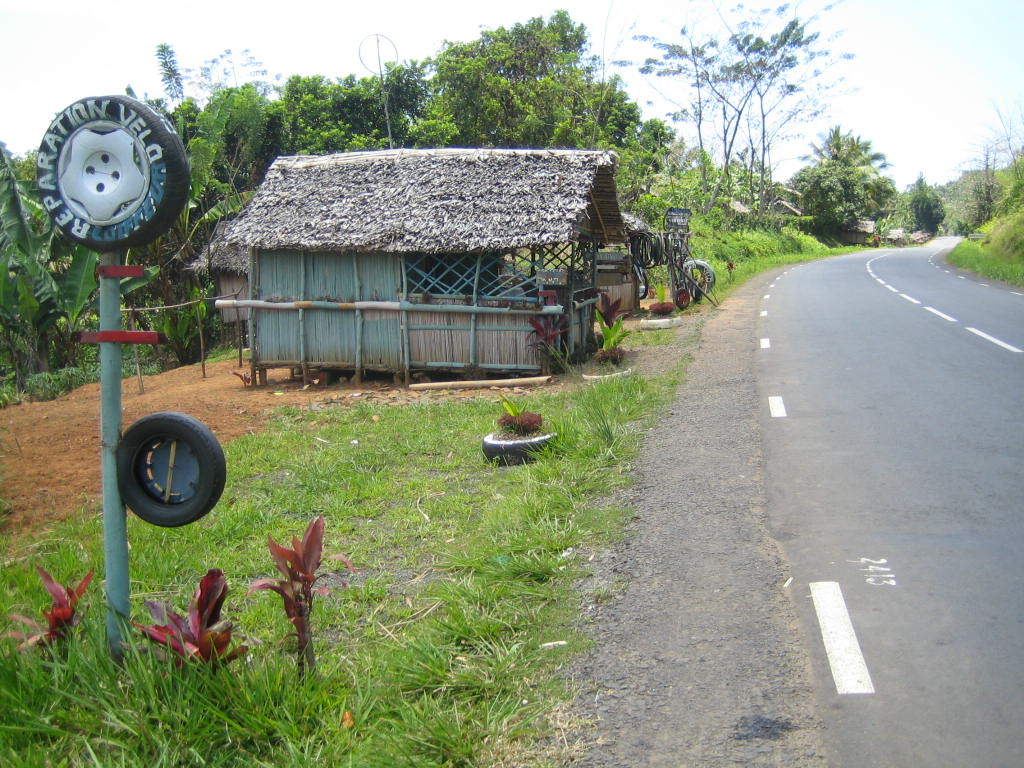
Since it was still relatively early and I knew there was a supermarket, I set off again. As I was riding through the city, on my bike of course, but without any luggage, which was much more pleasant, I suddenly caught a very strong scent of cloves. I followed it and saw dozens of people sitting on the floor of a house, sorting cloves.
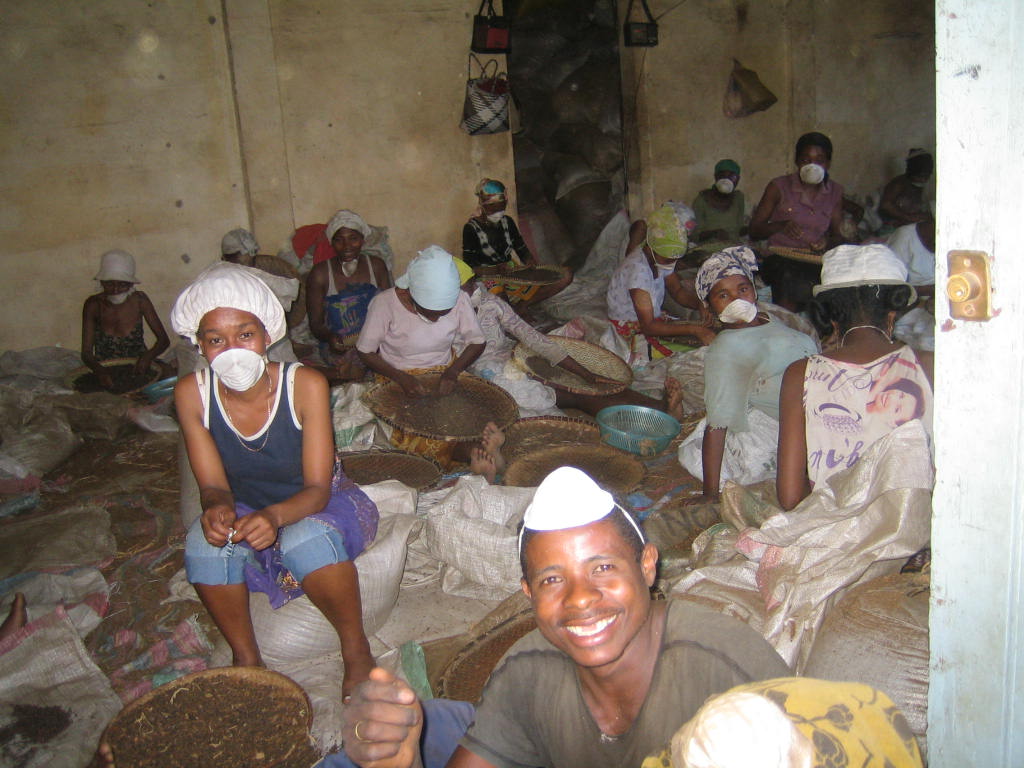
Some people in our country think they have to complain about their jobs without knowing what else might be possible.
Foulpoint (Mahavelona), 75 km, Tuesday, October 24, 2006
Today was one of the best days of cycling. Although that wasn’t the plan at all. I actually only wanted to cycle the few kilometers to the zoological garden, where there is also a campsite. That’s why I was able to take my time leaving Tamatave and go shopping again briefly. I paid for the room until noon, and wherever I am, I am and remain a Swabian! It only rained very lightly all morning, so I didn’t feel the need to take out my rain jacket.
I didn’t have my creative phase during the first few kilometers out of the city. That only came after about 30 km. First, I had to battle through rain, traffic, and potholes. The last 4 km to the Zoological Garden were on a dirt road, but it was wonderful through a forest, along a river where pirogues were bustling about. The “campground” didn’t appeal to me at all. There was nothing but tables and benches, no roof or other shelter. Considering that I had expected more rain and it was still quite early in the day, I decided on the spot to turn around and continue on. What was I supposed to do alone in the rain in the forest (= rainforest)? From then on, things got better, with the rain and traffic stopping. However, the humidity here is probably around 94%. The route was almost flat, without being boring. There were lots of curves, sometimes right by the sea, sometimes with a dune in between, sometimes running between the canal and the sea, and always lots and lots of palm trees.

Suddenly, watermelons were also available for purchase at stands. Unfortunately, they are much too large, and a cut piece did not exactly whet my appetite. Who knows how long they have been sitting there. The main thing is that the mosquitoes had their fun. I enjoyed riding so much today that I even entertained the Madagascans with my singing. That’s different here than elsewhere; they all laugh when they see me. So the tour is good for others too.
This is a really nice village. Three boys escorted me to my bungalow. The complex is very nice, with very simple huts, but with a shower and toilet. I decided that if it cost less than 20,000, I would stay for two nights. Great – it only cost 16,000. It almost looks like a vacation day is coming up.
Foulpoint, 0 km, Wednesday, October 25, 2006
The Indian Ocean is simply not suitable for swimming, but rather for hiking, aqua hiking or ‘nautic walking’ would probably be more effective advertising. When I lay down flat, I was just covered with water. After a few hundred meters, it was as deep as a bathtub. Thetemperature was just right to be refreshing. So I spent the afternoon half in the water.
The morning also passed without any major activities: just lounging around, writing postcards, reading, writing, sweating, drinking, and fending off pirogue drivers. Sweet idleness – but one day is enough! It’s just more pleasant on a bike. There are hardly any tourists left, so everyone who has something to offer pounces on you. Chains, chains, shells, coconuts, and pirogue rides again and again. Most of the sellers are between 10 and 13 years old. Since I had nothing better to do anyway, I struck up a conversation with them.
- Wonderful chains, prix spécial – I already have chains,
- but these are special,
- you don’t know mine,
- but they are really special
etc., and the kid had a grin on his face, as if he wasn’t really that interested in selling. When I asked them why they weren’t in school, they replied that either the teacher was sick or they didn’t have a notebook. I promised one of them that I would buy him a notebook if he promised to go to school.
Fenoarivo (Fenerive-Est), 67 km, Thursday, October 26, 2006
The youngest siblings always get the short end of the stick, and that’s true here too, except that here you have a better chance of not remaining the youngest for long! I made this valuable observation today at the “beach” – beach in quotation marks: there is water, there is sand, but it was still not inviting.
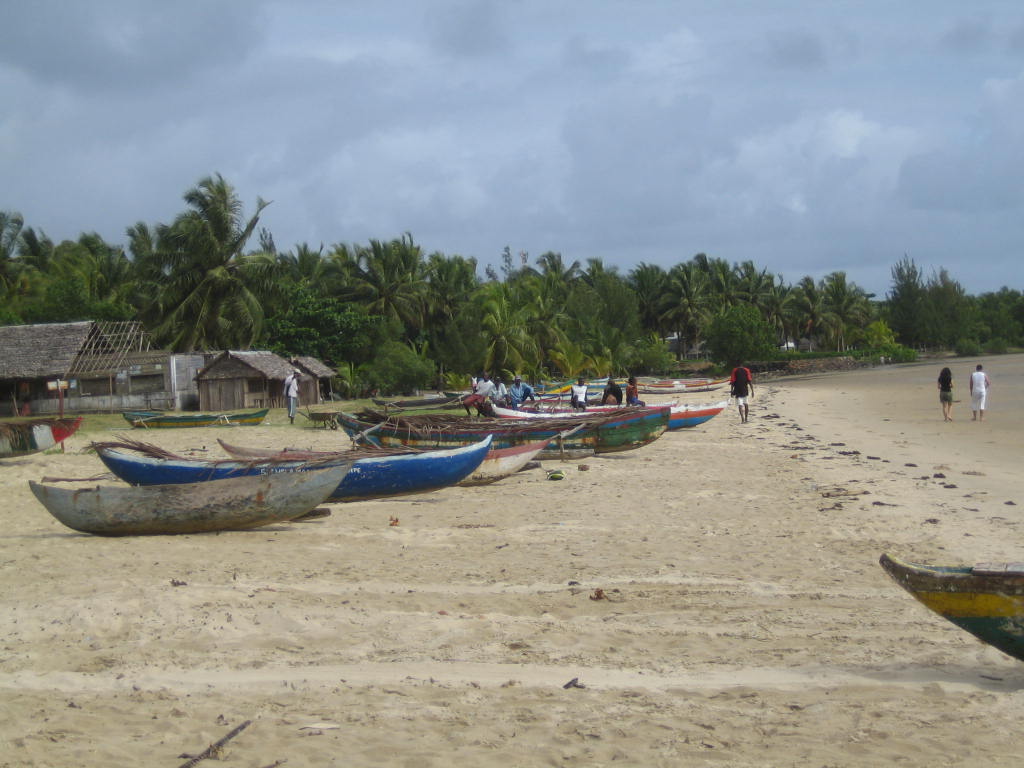
Only children, except for the youngest siblings, were splashing around in the water. Meanwhile, the poor little ones had to carry around the clothes and shoes of the older ones.
I’ve also grown very fond of the Madagascan habit of lying down somewhere at lunchtime. I quickly covered the few kilometers from Foulpoint to here and took a look at Mahambo, where I will be spending the night on the way back. At lunchtime, I had already dropped off my luggage at my next accommodation. This allowed me to lie down unhindered among the sleepers. I chose the wall on the beach for this purpose. It was really extremely pleasant to lie in the shade in the gentle breeze during lunchtime. To make it even better, I listened to music.
After a while, two schoolgirls sat down next to me. I was reluctant to be interrupted, but the song was almost over anyway, so I was able to engage in conversation. After all, I wanted something from them too: why not do something for historical education and visit the old fort? Only my guidebook is the worst I’ve ever had. It only mentions that there is a pirate fort. So I had to ask someone anyway, and why not the two schoolgirls? They knew immediately what I was talking about and wanted to accompany me there. Based on my experience, I immediately assumed they were after souvenirs. Since I wanted to cycle there, I first asked if they had bicycles. They said you could also walk there. My guidebook reveals one more thing: it’s about 3 km away, and I didn’t feel like walking 6 km. Of course, they didn’t have a bike, but they wanted to get one on the way. They kept discussing where they could get one. “Bicyclette” was the only thing I really understood in Malagasy. Unfortunately, the person they went to see sent them away again. There probably weren’t any bikes available at the time.
Here in Fenerive is the first place where they came up with the idea of attaching a pousse-pousse to a bicycle. Riding a bike is easier and faster than running around the area all the time. Of course, they also knew one of the rickshaw drivers. But they realized themselves that the price was too high, although I didn’t really notice how much it was. Finally, when it seemed that it was just straight ahead and you could vaguely see the indication on an old rusty sign, I thought I could quickly ride there myself and they could wait here. So I set off. It was straight ahead, but at first I couldn’t believe it and continued along the road, which curved slightly to the left, and ended up at a school. I really should have continued along the footpath. So I turned around and headed into the “bushes.” At a river, you could see that there used to be a proper bridge here. Now it had collapsed and been replaced with a few wooden planks.

Since this ‘bridge’ wasn’t very high and the river wasn’t very deep, I ventured across with my bike. After that, I continued along a beaten path until it went up the mountain through the bushes. This really doesn’t seem to be a place that is frequently visited by tourists or anyone else. A tower was already visible from a distance. However, it dated back to the 20th century rather than the 17th. If you looked closely, you could see the old wall behind it, completely overgrown.
It is amazing how the Madagascans deal with their history. After all, this was once the first capital of the Betsimisaraka, whose king united all the tribes in the east for the first time. One of the first mergers for the sake of synergy. Apparently, the past plays just as little a role as the future, except for my students. They seem to be 17 years old, but I think they are more like 14-15. I had to photograph them posing, and now they dream of German husbands, whom I am looking for for them with the photos.

They’ve probably never seen a German man before. Almost every man here has an astral body. The advantages of a German man are: he’s white, hopefully tall and blond, and definitely has money compared to the Madagascans. Back in town, I invited them for yogurt and cookies and had to promise a hundred times that I wouldn’t forget them! I had dinner at the restaurant that belonged to my accommodation: fries with grilled chicken. When a plate full of fries arrived, I wondered whether I should start with that or wait for the chicken. Suddenly, I saw a few bones sticking out from under the fries. No wonder so many people here are so slim. It was fine with me, as I wasn’t that hungry anyway.
Soanierana Ivongo, 67 km, Friday, October 27, 2006
You can really get used to this: half a day of cycling and half a day of hanging around. It’s almost too warm for sporting activities anyway. And with the coolness comes darkness. But I really enjoyed the cycling again and I’m looking forward to cycling more tomorrow. The route is so beautiful that I don’t mind at all; on the contrary, I’m looking forward to riding back again. I spent the second half of the day at the Marimbona River, almost directly at its mouth where it flows into the sea. This is also where the paved section of the RN 5 ends. Those who want to continue can cross over in a pirogue.
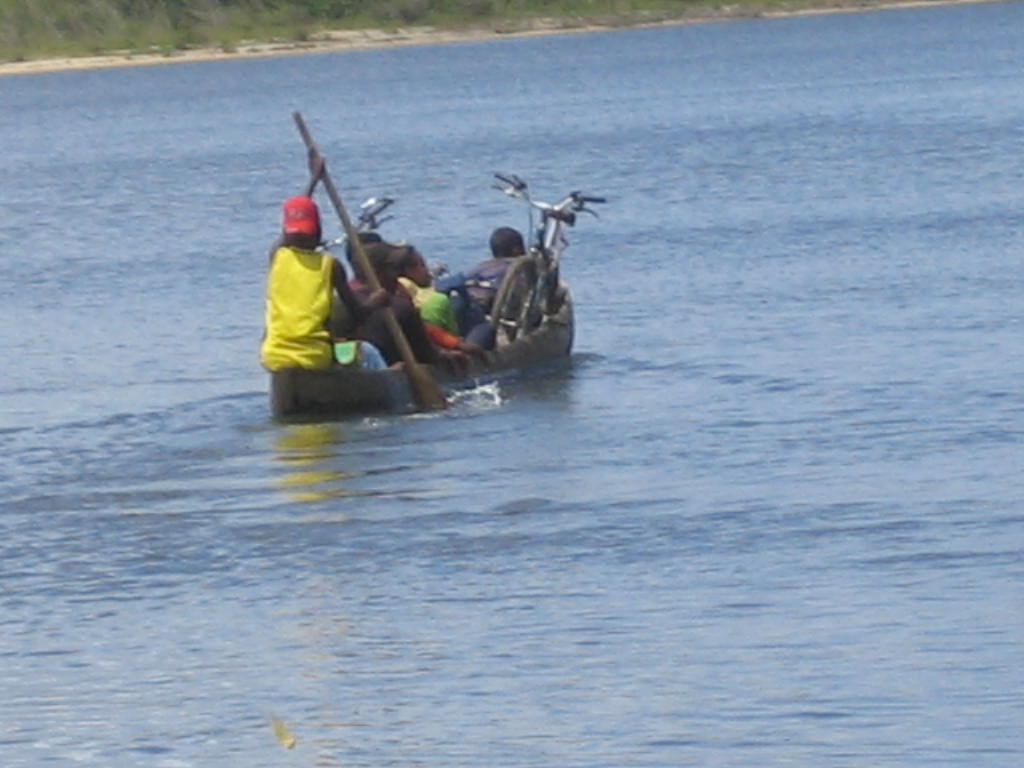
There is also a proper ferry for cars, which has run twice so far. (How many hours? I sat here for what felt like an eternity). Tourists actually come here to cross over to the tourist island of Sainte Marie or to continue north by boat. Further north, there are a few more interesting places, such as Maroantsetra and Masoala. Unfortunately, I won’t be able to visit them this time. I’ll also give the island a miss. Lying around on the beach is just not my thing, and there’s not much else to do there.
Fortunately, the place here is quite small. Soon everyone knew that I really didn’t need a boat to go anywhere, but that I was just staying there. There are no tourist attractions and the beach is not suitable for swimming. I don’t know why, but in any case, no one does it, so it’s better to leave it alone. There are also sharks here.
As usual, there is also a market here, but unfortunately no fruit other than bananas. It’s not very varied otherwise either, mainly tomatoes and some green stuff. All the cloves that were dried on the way here are apparently intended for export.
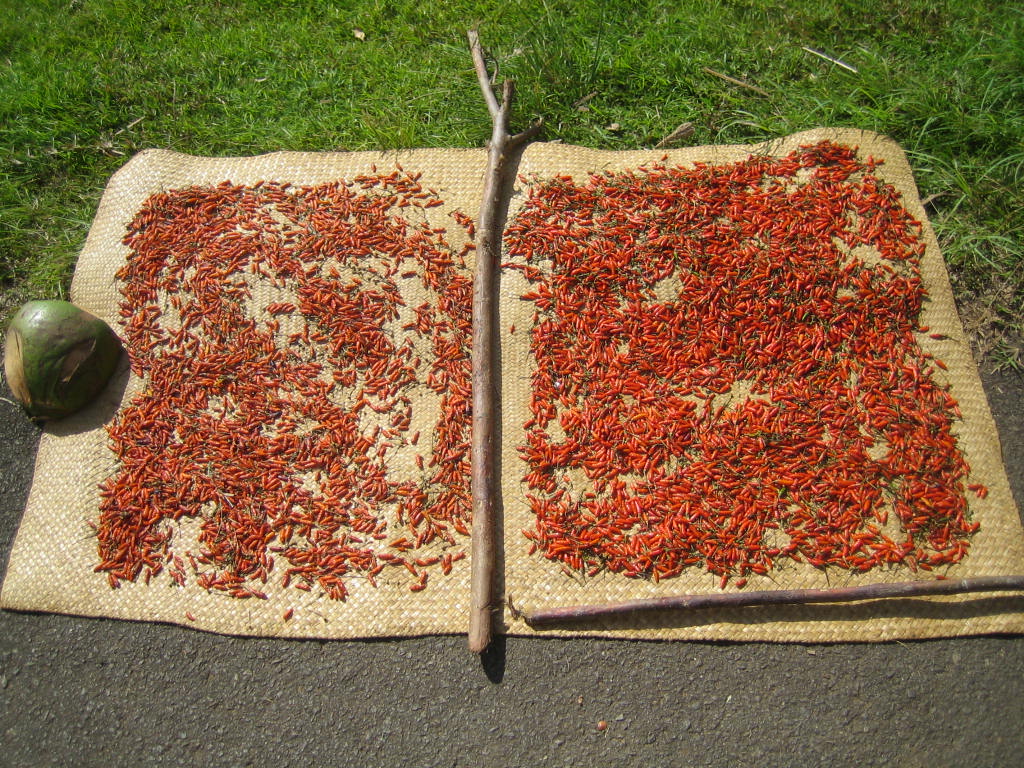
The smell gets you in the mood for Christmas, but if you inhale it for too long, it makes you feel quite dizzy. Huge quantities are harvested here, and I wondered what the plant on which the cloves grow might look like, until I finally saw older women sitting by the side of the road, plucking the cloves from a flower. That was an important clue, because soon after, I saw the women harvesting them from the trees. The ladder alone was a clue. It grows practically like linden blossoms.
The advantage of a non-touristy place is that no one is constantly trying to sell you something. So I had my peace and quiet for the most part today. The atmosphere by the river was very nice, but when I wanted to write in my journal at sunset, a horde of girls surrounded me. And they weren’t shy at all; they didn’t know anything about the safe distance I was used to. They became clingy in the realest sense of the word. A few of them looked desperately poor. At least they go to school part of the time and can read and speak French. When it was almost dark, most of them disappeared at once and I said goodbye. Now I’m sitting in front of my bungalow, where I’m being bothered by flying bugs.
Mahambo, 83 km, Saturday, October 28, 2006
The return trip was at least as enjoyable as the outward journey. A stronger wind came up from the side, which made the whole thing take longer, and it wasn’t nearly as hot.
There are really incredibly different types of palm trees here. If I were to cycle this route a few more times, I’m sure I would discover a few more. The other plants are also very diverse. For example, there is a huge tree that looks like a cotton tree, full of fluffy things instead of apples or pears, but as tall as the cotton tree is, you couldn’t harvest them anyway. There are also conifers with needles growing directly out of the trunk. They only have a few thick branches. Quite interesting and diverse, “biodiversity,” as the buzzword here is called.
As mentioned at the very beginning, you are rarely alone when cycling here. Many Madagascans also ride bicycles and seem to particularly enjoy riding with me. Actually, I don’t mind when someone rides behind me, but the clattering, rattling, and squeaking literally drive me crazy. As soon as the road goes uphill, the Madagascans push their bikes. They only have one gear, with or without a derailleur, because it hardly ever works. It’s quite frustrating when I overtake them with all my luggage. I’m also faster going downhill, because they don’t dare to ride so fast. In very rare cases, the bikes have brakes. Braking is done like inline skating: you simply ride into the grass or use the sole of your shoe against the front tire, if you’re wearing shoes at all. Only on flat ground do they catch up with me. It’s also worth mentioning that they rarely ride their bikes alone. Most of the time there are two, if not three, on them – mind you, we’re not talking about tandems here, but almost normal bikes. Well, if you’re a girl and you have a boyfriend or big brother, then you get a ride to school.
As I was riding along, I suddenly heard music. A few women were dancing near some huts. Of course, I stopped and, as usual, was immediately surrounded by a horde of people. Unfortunately, the men were slightly drunk, so they weren’t dancing. Nevertheless, I managed to find out that it was a festival of death, “Fête de la Morte.” November 1 is All Saints’ Day here too, and they celebrate it for three days with joyful exuberance. That’s what I really like about Malagasy culture: for them, death is something natural, they almost look forward to it. I decided to decline the invitation to stay, as there was too much alcohol involved.
In Mahambo, I can finally camp again, almost right by the sea. The water here is much stormier, with high waves, and it is deeper. It’s finally worth going into the water. So I treated myself to a swim before cooking some soup in front of my tent. Oh, it’s so beautiful here, this is the life.
Mahambo, 13 km, Sunday, October 29, 2006
Thanks to a Swiss couple, this rainy day turned out to be quite nice after all. Even so, I’m far from complaining, as I’ve had so many sunny days. Today would have been my beach day anyway. After a rainy night, it was actually quite nice this morning. Before heading to the beach, I wanted to go for a little bike ride first, as I can’t last a whole day on the beach. It was just before noon when I got to the beach, and I realized right away that I couldn’t stay long. I only stayed for 30 minutes. Then it started raining and practically didn’t stop. A Swiss couple offered me one of their deck chairs in front of their bungalow. Very nice. I couldn’t leave. I read, listened to an audiobook, and when they were there, I talked to them, of course. I didn’t even get around to making tea. It really rained constantly. Quite unusual, according to the people here. It wasn’t supposed to start until the evening. They probably won’t be spared from climate change either.

Apart from not being able to go in the sea, I didn’t miss anything that day. The lounger was quite comfortable, which wouldn’t have been the case on the beach. This is one of the only places where you can really swim. It’s a shark-free area. The two Swiss guys were here for a whole week and took a surfing course. Apparently, the other participants were the offspring of wealthy Madagascans from Tana. The things you find. I’m actually quite glad that the course was over when I arrived. But even in the evening, they still wouldn’t leave me alone. It’s their own fault for asking me if I wanted to join them for dinner. Then they have to expect me to say yes. But I didn’t want to turn down an evening of German conversation. That’s how I found out that a plane had crashed near Toliara. I usually live here in a total news-free zone; I’m not even interested in the weather map. Hopefully, everyone at home knows that I’m on the east coast and Toliara is on the west coast.
Tamatave, 98 km, Monday, October 30, 2006
Today was my social day. First, I had to go through Foulpoint again. Because this is the only town before Tamatave, I stopped and was immediately recognized by the boy I had promised a few days earlier that I would buy him a notebook so he could go to school. I wanted to do that, but I hadn’t seen him again. So I bought him a notebook, but wrote his name on it right away. He then promised me that he would go to school the next day. I don’t really believe that he will, which is a shame because he is a nice, smart little boy.
Back in Tamatave, a little boy wanted me to buy him a plate of rice. You can’t refuse a poor child something like that. Besides, it’s not usually that expensive. But this little rascal had picked out a “luxury restaurant.” By the time I got there, he had already ordered. Not just rice, but meat as well. That ended up being considerably more expensive than what I would treat myself to. He also got a large plate full. I should have stayed there and seen if he ate everything.
The bike ride was once again a pleasure, and I almost always had company. At the beginning, there were two boys for about 10 km, which was quite fun. The poor guys will surely have sore muscles tomorrow. I still felt quite fit and enjoyed riding faster. The two could hardly keep up. But then again, they’ve probably never been so fast at school.
On the last stage, another cyclist tagged along with me, but somehow he annoyed me. I can’t even say why. It probably wasn’t his fault at all. Every now and then he rode next to me. I can’t stand that because it’s far too dangerous. Nevertheless, I tried hard to stay calm. After all, it’s their country and I’m just a guest here. I stopped at a village on the beach. This time, for a change, I didn’t want to eat anything, I just wanted to get rid of the guy. But he stopped too, a few hundred meters further on. I stood there fuming for a few minutes until I quickly jumped on my bike and sped off. He probably realized right away that he couldn’t keep up with me, because he decided to stay where he was.
After two nights in a tent, I thought I could treat myself to the Miramar, the cheapest option, of course. I like it here, it’s right by the sea and has a 50-meter swimming pool. My bungalow is one of the ones at the back. Of course, the luxurious ones come first. For me, that’s great, I’m quite secluded here, I can cook my own soup and enjoy the sound of the sea. From tomorrow, that will be over. The end is fast approaching.
Antananarivo, 20 km, Tuesday, October 31, 2006
So the trip is coming to an end quite quickly. And once again I’m at the Hotel Sakamanga. It’s just nice here, a real haven of peace in this terrible city. Since tomorrow is a holiday, I had to go souvenir shopping today. I’ve never spent so much money here in one day. But it already started this morning at the airport. 15 kg of excess baggage, which also costs money here. This time it was only economy and not business, so 20 kg instead of 30 kg of free baggage allowance. After that, I didn’t have much money left. When you go to get money, it’s like going shopping when you’re hungry – you buy too much. I never would have thought that I could get rid of it so easily. What is really cheap here is what Madagascans need for their daily lives. But as soon as it deviates from that, such as postcards and stamps, and especially souvenirs, the prices are almost European.

Back in the city, all the misery overwhelmed me again. I felt like everything was hanging on me. The rich Madagascans are left alone. Although, they should be the ones to go after. That’s where the solution to their problem lies.
I was really relieved when I met a Frenchman I had already seen in Morondava and Ambalavao. But even with him, I was the “victim”; it was never ‘Messieurs’ but only “Madame, Madame, prix spécial extra pour vous. … Madame d’argent, Madame mangere, – Madame here – Madame there…” They should go after the rich Madagascans, there are plenty of them, then maybe they would see that something is wrong.
It was quite nice to stroll around a bit with Patrick. Then I went back to the hotel, where I wolfed down my dinner in front of the TV. If you’re paying for all the luxury, you might as well make use of it. Even in Africa, I am and always will be a Swabian. It was so nice that I considered booking the room for another night, even though I have to be at the airport at 10:30 p.m.
Antananarivo, 14 km, Wednesday, November 1, 2006
So, the last hour is about to strike. But first, there’s the “last meal.” I’m liking this Hotel Sakamanga more and more. That alone would be a reason to come back.
Before, I was probably a little too masochistic. I was on the internet checking the weather in Germany, as if it weren’t enough that it was really catching up with me. It was anything but motivating to fly back to Europe. When I had a room for the following night, I went out to see if I could still spend some money somewhere. Hard to believe, but almost all the shops were closed. On the other hand, it was much quieter. Besides, every taxi driver now knows that I really don’t want a taxi.
Otherwise, the city doesn’t have much to offer. So I went back to my hotel and got my bike. There was actually one hill I hadn’t climbed yet, and it was one of the most important ones, where the castle of the mad queen Ranavalona stands, the royal house whose construction cost the lives of quite a few slaves because they had to haul huge tree trunks from the coast to the highlands. The whole thing was made almost entirely of wood, so it could burn down again almost unhindered. That was not so long ago, around 1996. I don’t think anyone died in the fire.
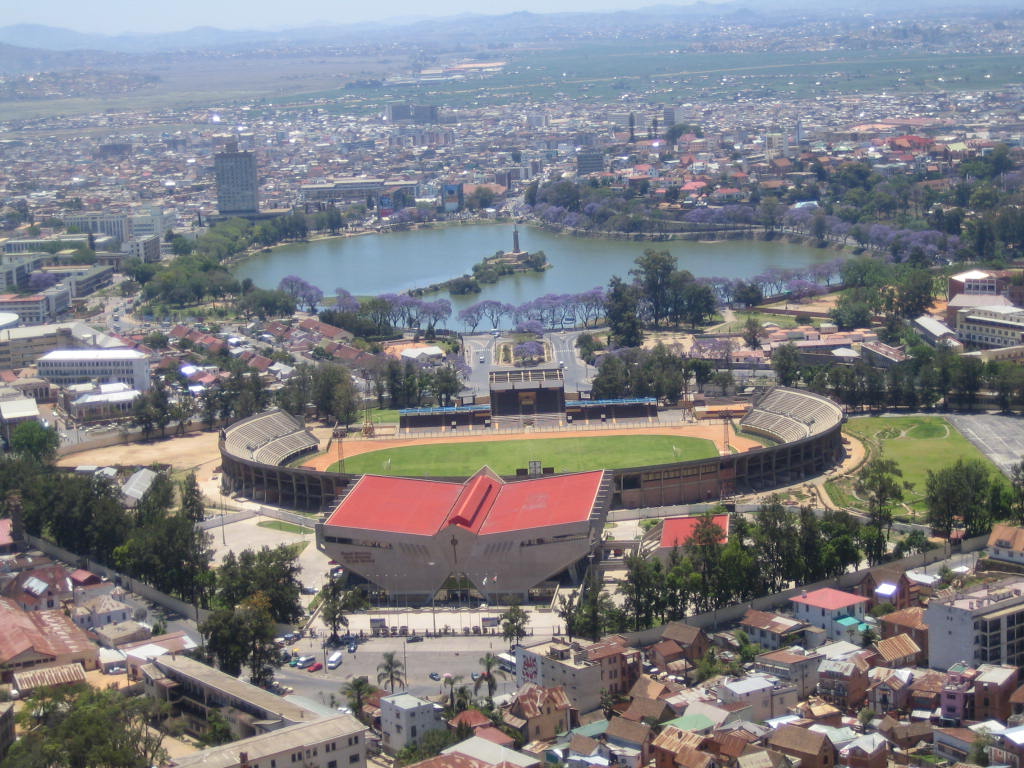
Because this building is quite important to Madagascans, a real cultural heritage site, there were plans to restore it. But since slavery is not viewed very favorably these days, the whole thing would be quite expensive. Nevertheless, what appears to remain is said to be worth the effort of cycling up there. Once I reached the top, I had a great view in practically all four directions, but the area where the ruins of the old royal castle stand was cordoned off—due to renovation!
So they did spend money after all. But somehow I had the feeling that if I came back in 10 years, not much would have changed. At least I was greeted at the top by one of the guards, who told me I was the first person to arrive here by bike.
There is also a museum up there, but I didn’t feel like visiting it. The weather was much too nice for that. I much preferred to ride my bike – there must be something wrong with me, because even after five weeks of cycling, I still haven’t had enough. I happily whizzed down the other side of the mountain – until I found myself in a dead end. There was absolutely no way forward. The main thing was that the children were happy to see a vazaha on a bike here. So I turned around and headed back to the city center to explore a few more areas I didn’t know yet, which didn’t turn out to be all that worthwhile. It was quite unpleasant. Since all the merchandise was laid out on the sidewalk, half the street was full of pedestrians. I had to find my way between them and the buses. I decided it would be better to go back to the hotel. The bike still had to be dismantled. Thanks to some very nice helpers, this went quite quickly.
Paris Orly Airport, Thursday, November 2, 2006
A nice surprise awaited me at the airport in Tana. First, I checked in as usual and then went to a counter where I had to pay the fee for my bike. There, they realized that I had only checked in to Paris and had to pick up my luggage there. I was very surprised by this. Finally, the woman found out that I had to change airports there. Great. After ranting about Air France, I had to agree with the woman who said I could have seen this earlier. She was right, and it was a real lesson for me. I tried to calm down, because despairing wouldn’t help and wouldn’t solve the problem.
The flight from Madagascar to Paris wasn’t very pleasant. I couldn’t sleep and didn’t have a seat by the aisle. At first, I was able to watch movies, but then I felt so sick that I just hoped it would all be over soon. The nausea passed and I was able to watch another movie. Except for the fact that changing airports was a huge waste of time—I saw that there was a flight from Charles de Gaulle to Mulhouse shortly after I landed—it wasn’t a problem. It only cost me an extra €16 for the airport bus, and I could take my bike with me for free. In return, I got to see the Eiffel Tower. Otherwise, waiting for my luggage and checking in again is quite annoying. I quickly talked them out of charging me €80 for my bike. So now I was only a few hours away from my home airport.
Final thoughts:
While traveling in Madagascar, I met people, backpackers and very few touring cyclists, who didn’t like Madagascar very much. For me, however, it’s clear that this is one of the best countries I’ve traveled through by bike. The Madagascans are extremely hospitable, and you can find somewhere to stay everywhere. As the distances between villages are not so great and, thanks to the president, there is a tico everywhere, you rarely have problems with water. Unless it is too hot or during the rainy season, the weather is fantastic. (That’s why it was rarely mentioned in the report). Only when I was on the east coast could I have been a little braver and continued north on the dirt road. But it was just too comfortable. Besides, I still have the rainy season and the flight from Tamatave as excuses, and I have to save something for my next visit. The route is almost set, then it’s all the way south and all the way north.
Before I left, I thought it was almost too late for a trip like this to get to know the original Madagascar with its “unspoiled” people, that tourism had already taken over. Fortunately, that was not the case. Now I am convinced that I picked just the right time. Tourism is limited to just a few places that you can fly to directly or reach by off-road vehicle. This means that most of Madagascar remains untouched. On the other hand, I was able to enjoy a few paved roads that are still completely untraveled. This made it one of my most beautiful cycling trips.
